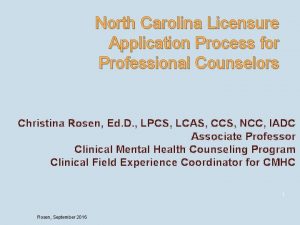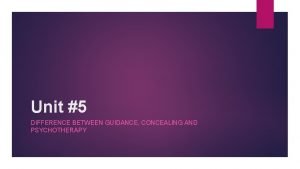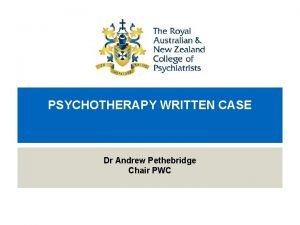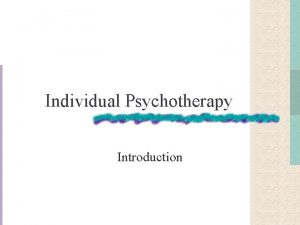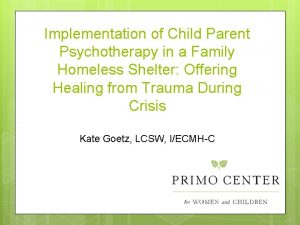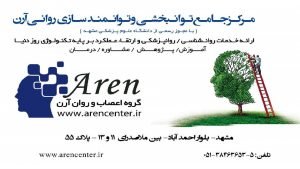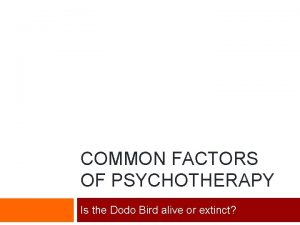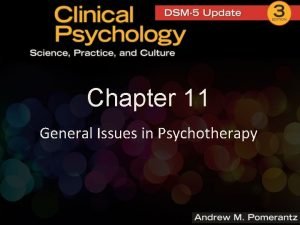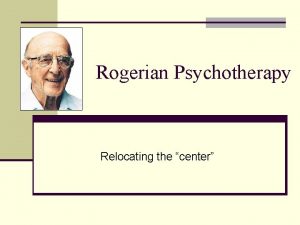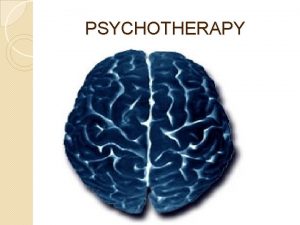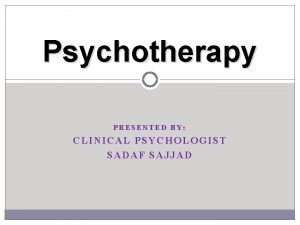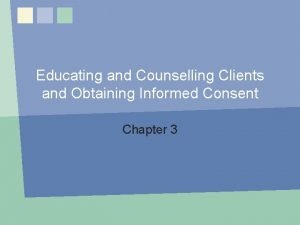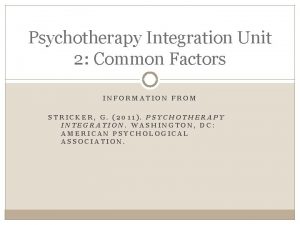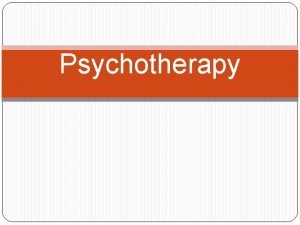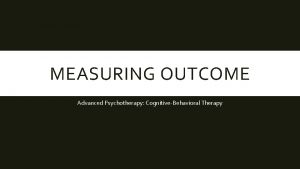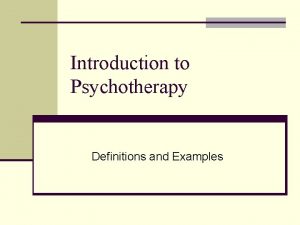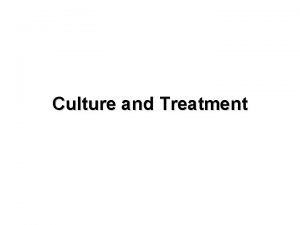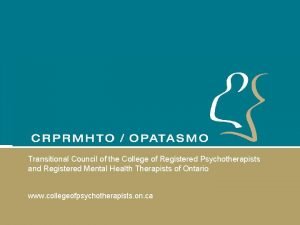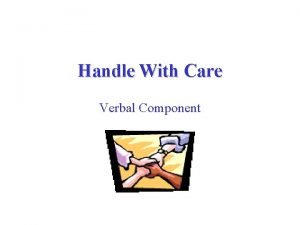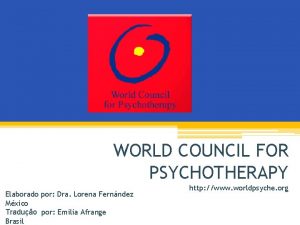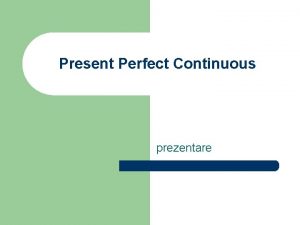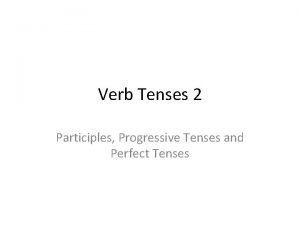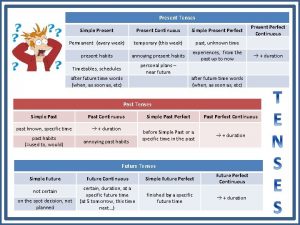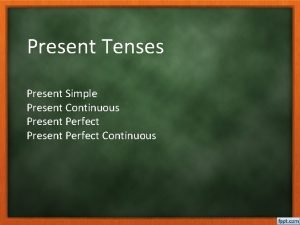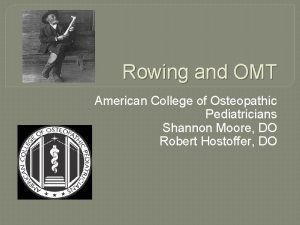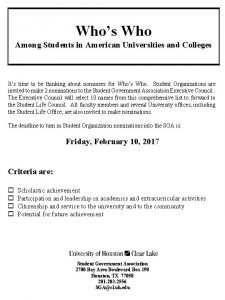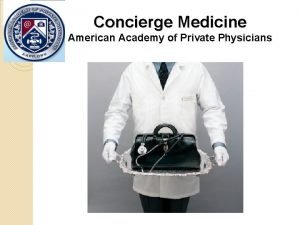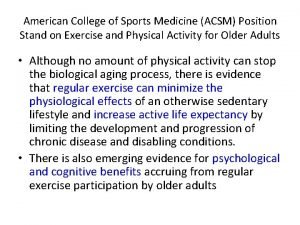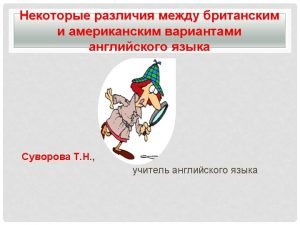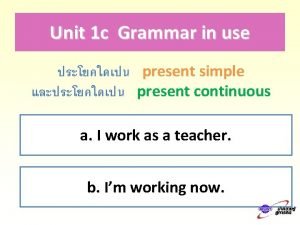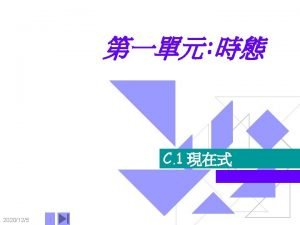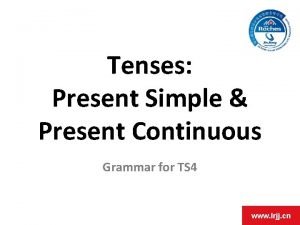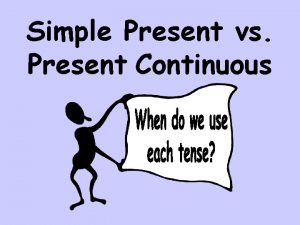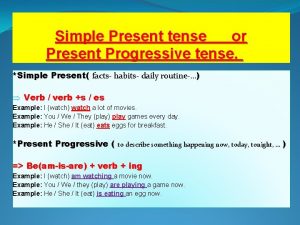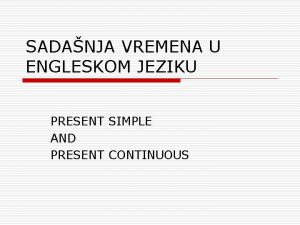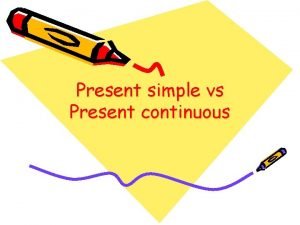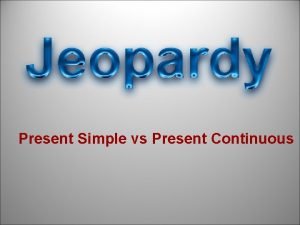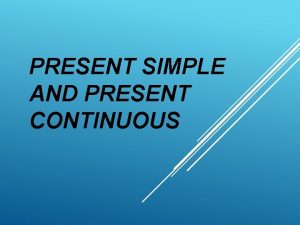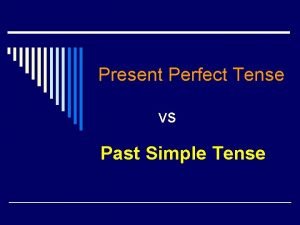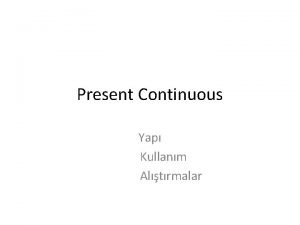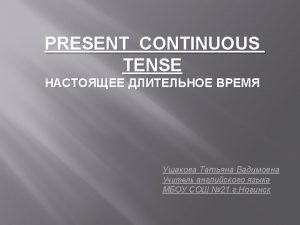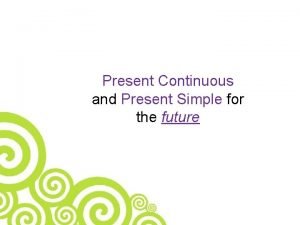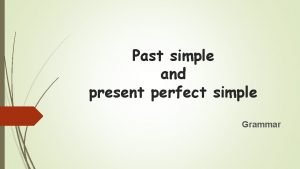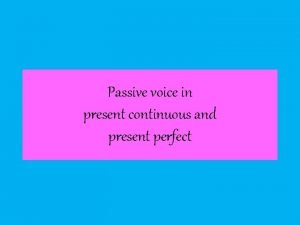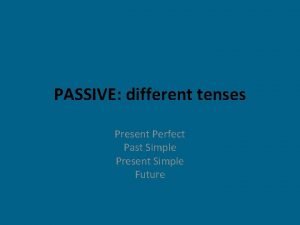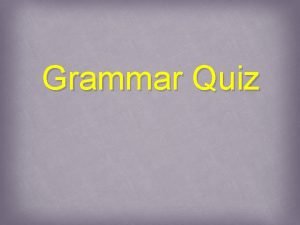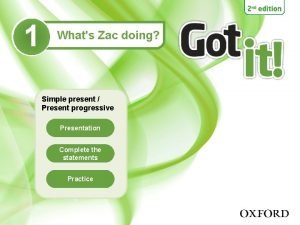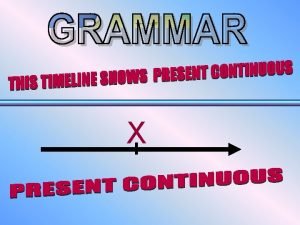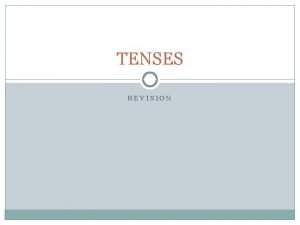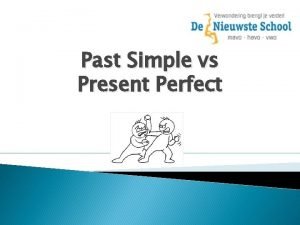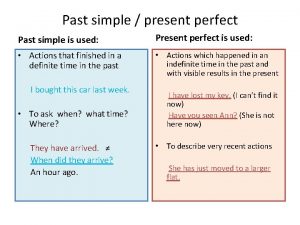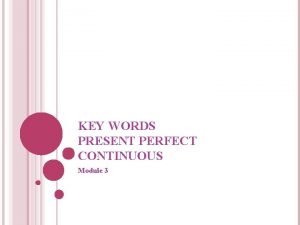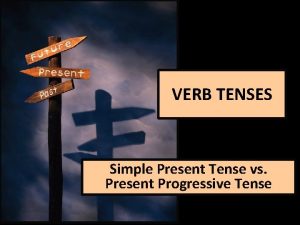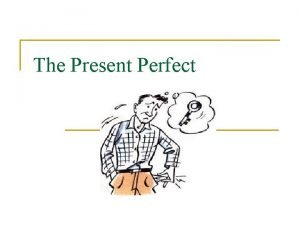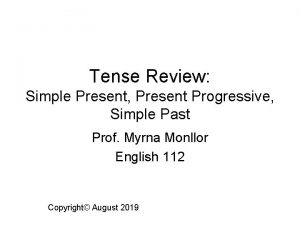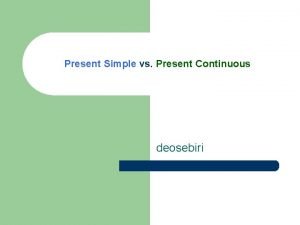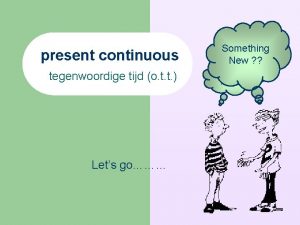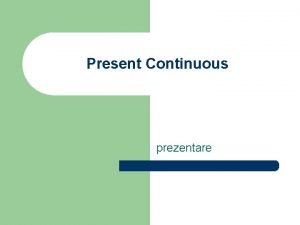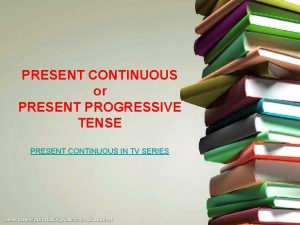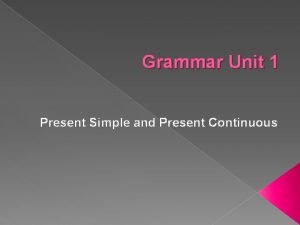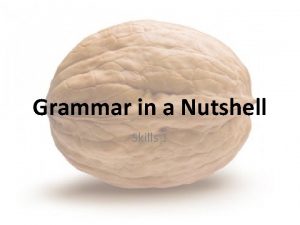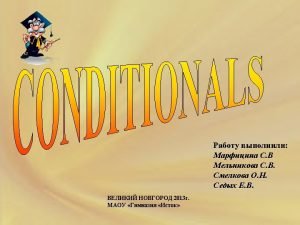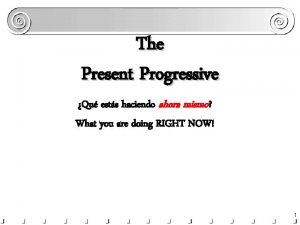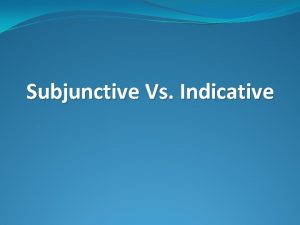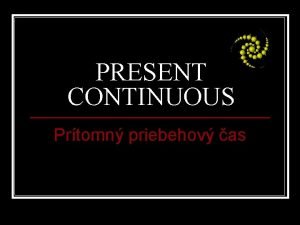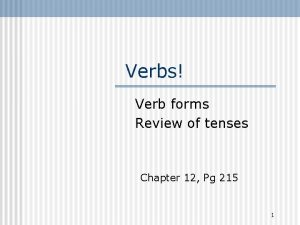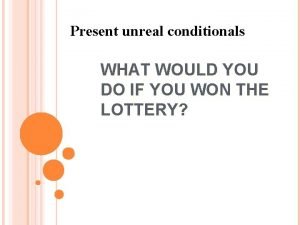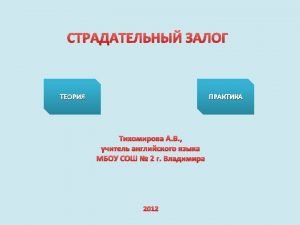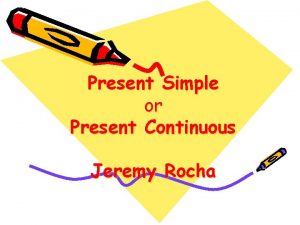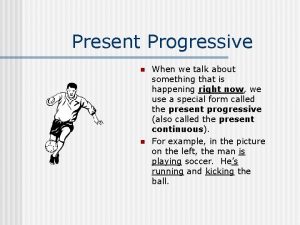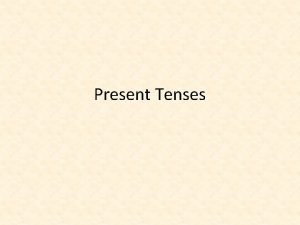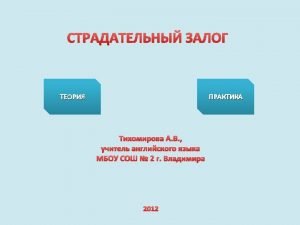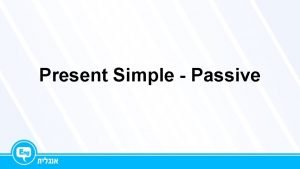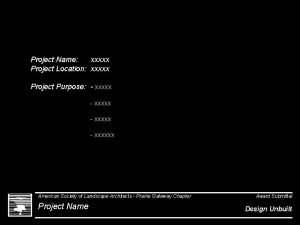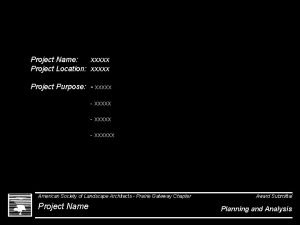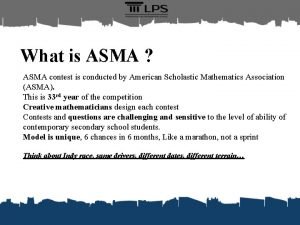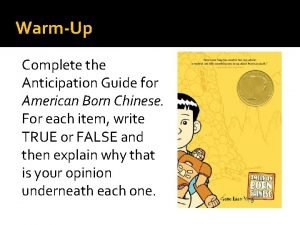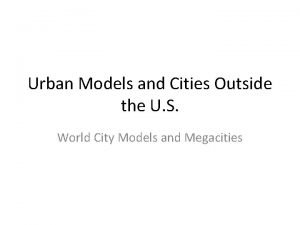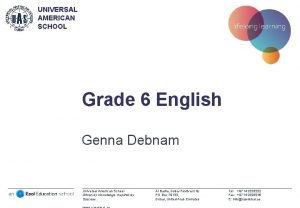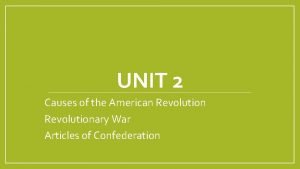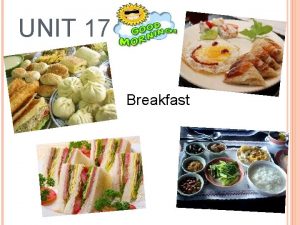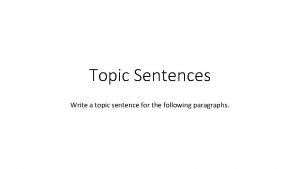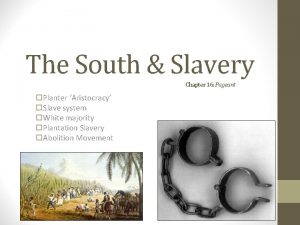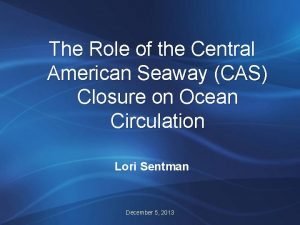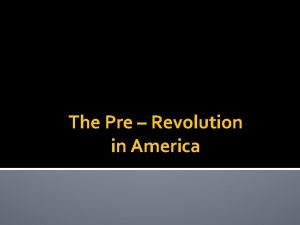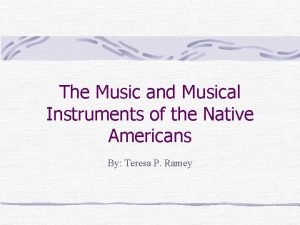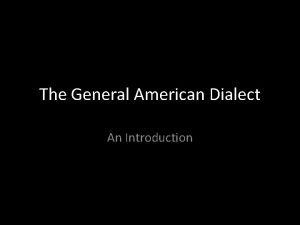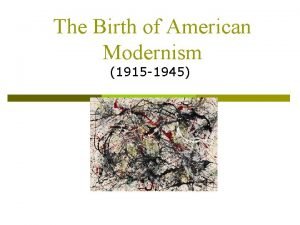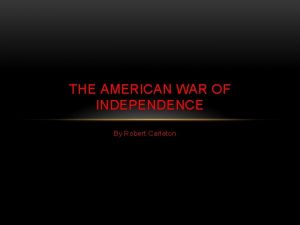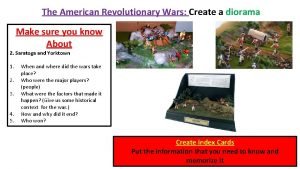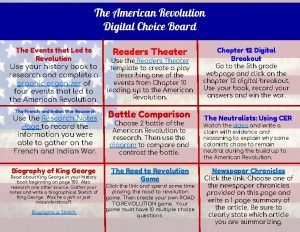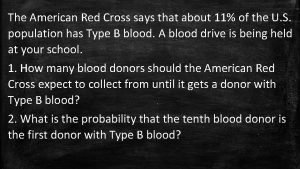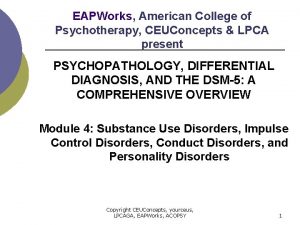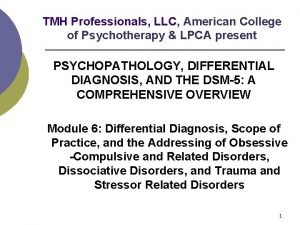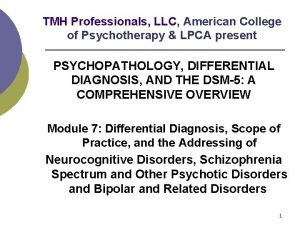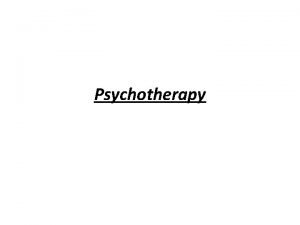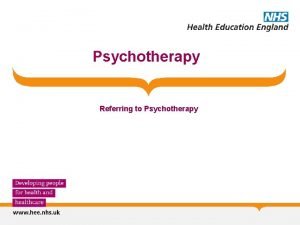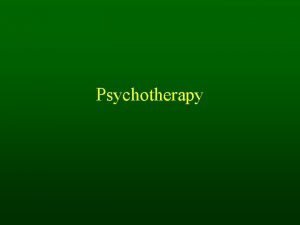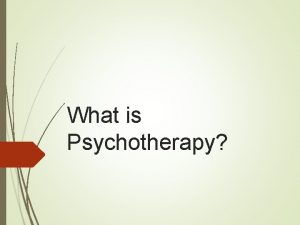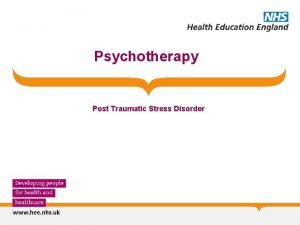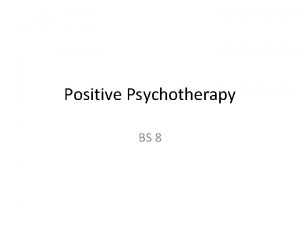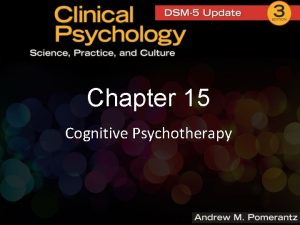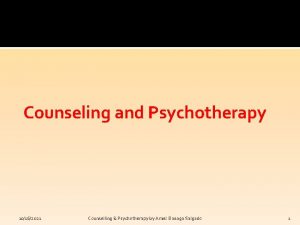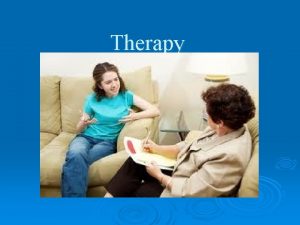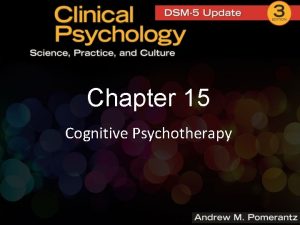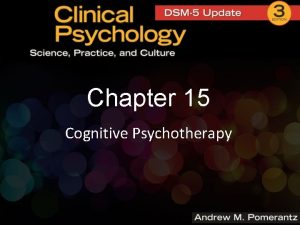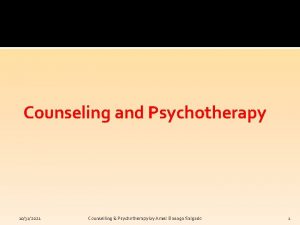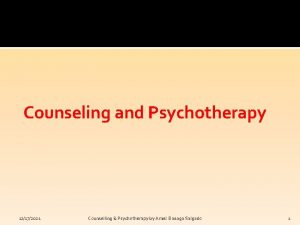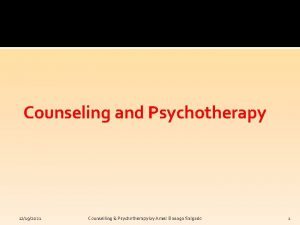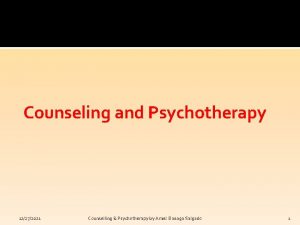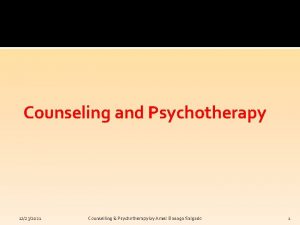EAPWorks American College of Psychotherapy CEUConcepts LPCA present
































































































































































- Slides: 160

EAPWorks, American College of Psychotherapy, CEUConcepts & LPCA present PSYCHOPATHOLOGY, DIFFERENTIAL DIAGNOSIS, AND THE DSM-5: A COMPREHENSIVE OVERVIEW Module 4: Substance Use Disorders, Impulse Control Disorders, Conduct Disorders, and Personality Disorders Copyright CEUConcepts, yourceus, LPCAGA, EAPWorks, ACOPSY 1

Your Presenters Susan Blank, MD Psychiatrist in private practice with 27 years of specialization in addiction and pain medicine and a highly experienced lecturer and trainer in the field of substance abuse. Rachel Hopkins, LPC Rachael Hopkins, LPC, NCC, CAADC, CCDP-D, CPCS, Clinical Services Coordinator. for the Department of Community Supervision Copyright CEUConcepts, yourceus, LPCAGA, EAPWorks, ACOPSY 2

Course Objectives Upon completion of this program trainees will: - Learn the etiology of substance use disorders based on current research - Comprehend the complexities of diagnosis for this disorder - Grasp appropriate assessment processes for determining substance use, role clarification and differentiation for master’s level clinicians, and appropriate referrals to other professionals in establishing substance use diagnoses - Comprehend differential diagnosis from other disorders with similar presentations - Apply common specifiers for substance use disorders - Learn appropriate treatment strategies based upon diagnosis - Learn the etiology of impulse control and conduct disorders based on current research Copyright CEUConcepts, yourceus, LPCAGA, EAPWorks, ACOPSY 3

Course Objectives Upon completion of this program trainees will: - Comprehend the complexities of diagnosis for this disorder - Grasp appropriate assessment processes for determining impulse control and conduct disorders, role clarification and differentiation for master’s level clinicians, and appropriate referrals to other professionals in establishing impulse control and conduct disorders diagnoses - Comprehend differential diagnosis from other disorders with similar presentations - Apply common specifiers for impulse control and conduct disorders - Learn appropriate treatment strategies based upon diagnosis - Learn the etiology of personality disorders based on current research - Comprehend the complexities of diagnosis for this disorder Copyright CEUConcepts, yourceus, LPCAGA, EAPWorks, ACOPSY 4

Course Objectives Upon completion of this program trainees will: - Grasp appropriate assessment processes for determining personality disorders, role clarification and differentiation for master’s level clinicians, and appropriate referrals to other professionals in establishing personality disorders diagnoses - Comprehend differential diagnosis with other disorders with similar presentations - Apply common specifiers for personality disorders - Learn appropriate treatment strategies based upon diagnosis Copyright CEUConcepts, yourceus, LPCAGA, EAPWorks, ACOPSY 5

Purposes Behind Diagnosis • Accurate diagnosis allows for consistency and standardization throughout all disciplines that address mental health concerns: medical, nursing, psychiatric, psychological, counseling, social work, marriage and family therapy • Accurate diagnosis allows for common ground to be established in terms of research concerning the effectiveness of various kinds of treatment • Accurate diagnosis can be used for shaping the client's treatment plan, aligning the treatment approaches research has determined to be most effective with the various diagnostic categories Copyright CEUConcepts, yourceus, LPCAGA, EAPWorks, 6

Section One Assessment and Diagnosis of Substance Use and Related Disorders Copyright CEUConcepts, yourceus, LPCAGA, EAPWorks, 7

Substance Abuse Problems (NIMH as applied to 2007) 1. Alcohol abuse over lifetime – 17. 8% of adult Americans Alcohol dependence over lifetime – 12. 5% 2. Drug abuse over lifetime – 7. 7% of adult Americans Drug Dependence over lifetime – 2. 6% Copyright CEUConcepts, yourceus, LPCAGA, EAPWorks, 8

Important Reformulations of Diagnoses in the DSM-5 • Substance-Related and Addictive Disorders All diagnoses that differentiate between 1) substance abuse and 2) substance dependence for all misused substances have been deleted. Replaced by: Substance Use Disorders with specifiers to rate the level of severity from mild to severe. Copyright CEUConcepts, yourceus, LPCAGA, EAPWorks, 9

Important Reformulations of Diagnoses in the DSM-5 • Substance-Related and Addictive Disorders No more use of polysubstance abuse. Replaced by: Substance Use Disorder listing each individual substance for which there is a use disorder. Copyright CEUConcepts, yourceus, LPCAGA, EAPWorks, 10

New Diagnostic Terms and Categories in this Diagnostic Section Added in the DSM-5 • • Caffeine Withdrawal (ICD-10: F 15. 93) Cannabis Withdrawal (ICD-10: F 12. 288) Tobacco Use Disorder (ICD-10: Z 72. 0) Gambling Disorder (ICD-10: F 63. 0) Copyright CEUConcepts, yourceus, LPCAGA, EAPWorks, 11

Complications of Substance Abuse Assessment Substance abuse is a disorder with neurological, psychological, cultural and social contributors. A thorough assessment and diagnosis process must cover all of these areas. Copyright CEUConcepts, yourceus, LPCAGA, EAPWorks, 12

- Pharmacological factors refer to the ingredients of a particular drug that affect the functions of the body and the nervous system and in turn affect social behavior. - Cultural factors are society’s views of drug use, as determined by custom and tradition, and these affect the initial approach and use of a particular drug. - Social factors refers to the belief that attitudes about drug use develop from the values and attitudes of other drug users, the norms in the community, subcultures, peer groups, friends, and families, as well as the drug user’s need for, and personal experiences with, using drugs. - Contextual factors are the physical surroundings where drug use takes place and these contexts influence the attitudes toward drug use and the types and amount of drug use. Copyright CEUConcepts, yourceus, LPCAGA, EAPWorks, 13

Three Factors • Tolerance • Physical dependence • Psychological dependence Copyright CEUConcepts, yourceus, LPCAGA, EAPWorks, 14

The Neurobiology of Addiction • • Conditioning from pleasure centers Physical changes to neurons Changes in brain metabolism Withdrawal avoidance Copyright CEUConcepts, yourceus, LPCAGA, EAPWorks, 15

Neurotransmitters Copyright CEUConcepts, yourceus, LPCAGA, EAPWorks, 16

4 Main chemicals related to mood change… Ø Dopamine Ø Serotonin Ø Norepinephrine Ø Gamma aminobutyric acid (GABA) Copyright CEUConcepts, yourceus, LPCAGA, EAPWorks, ACOPSY 17

Dopamine Pathway is concentrated in the front of the brain v Involved in regulating awareness of the environment and other higher information processing tasks v Abnormal functioning may lead to… vdifficulties in relating to others vsocial isolation vdistorted perceptions of the world Copyright CEUConcepts, yourceus, LPCAGA, EAPWorks, ACOPSY 18

Serotonin Pathways are widespread covering all major areas of the brain v Involved in regulating mood and aggressive, impulsive and suicidal behaviors v Abnormal levels related to… vdiminished ability to control impulses vdepressed moods vheightened risk of suicide Copyright CEUConcepts, yourceus, LPCAGA, EAPWorks, ACOPSY 19

Norepinephrine Pathways travel to many areas of the brain, including the cerebral cortex and spinal cord…chemical transmitter for Autonomic Nervous System (ANS) v Excitatory - enhancing the responsiveness of nerve cells v Major role in creating and maintaining mood states Low levels… >>> depression Excessive amounts may >>>mania >>>anxiety Copyright CEUConcepts, yourceus, LPCAGA, EAPWorks, ACOPSY 20

Gamma aminobutyric acid (GABA) Functions in the Central Nervous System (CNS) to prevent the excessive firing of neurons by blocking impulses from one cell to another v Calming, helps to block anxiety and stress related impulses v Shortage linked with panic attacks (intake of tranquilizers increases the body’s GABA levels) Copyright CEUConcepts, yourceus, LPCAGA, EAPWorks, ACOPSY 21

Contributors to Problem Use • • Genetic factors Personality factors Life circumstances History of physical, emotional or psychological pain or distress • Peer environments • Other mental disorders Copyright CEUConcepts, yourceus, LPCAGA, EAPWorks, 22

Components of Assessment: Methods of Gathering Information • • Patient self-report and self-monitoring Self-anchored and rating scales Questionnaires Direct behavioral observation Role play and analogue situations Behavioral by-products Psycho-physiological measures Goal attainment scaling Copyright CEUConcepts, yourceus, LPCAGA, EAPWorks, 23

Gathering Information During Assessment of Substance Use Disorder • All components of a thorough biopsychosocial assessment should be addressed • Careful gathering of the client’s substance use history, present and past, with thorough exploration of where the client may minimize or deny actual substance use • Family history of problems with substance misuse, mental illness, or traumatic events • Where possible, gathering history from other parties: family members, significant others, work and social relationships where possible • Use of screening tools specifically designed to uncover substance use: e. g. , MAST, SASSI • Where appropriate, laboratory screening of substance presence Copyright CEUConcepts, yourceus, LPCAGA, EAPWorks, 24

Psychological Tests and Screening Tools The following web site contains a substantially complete list of current psychological tests and screening tools for a wide range of mental health concerns, including substance abuse. http: //www. scalesandmeasures. net/search. php Mental health clinicians must remember to use only those tools that fall within their area of competence. Copyright CEUConcepts, yourceus, LPCAGA, EAPWorks, 25

Gathering Information During Assessment of Substance Use Disorder • Use of Motivational Interviewing techniques, where needed, to reduce resistance and diminish the likelihood of treatment dropout • Building motivation for treatment as the development of therapeutic process begins Copyright CEUConcepts, yourceus, LPCAGA, EAPWorks, 26

Complications of Substance Abuse Diagnosis • Is the substance use culturally syntonic? • Is substance use problematic enough to warrant a diagnosis of substance use disorder? • Is substance use the primary problem or secondary to another medical or mental disorder? • Is the use of substances obscuring the presence of another disorder or responsible for the development of another disorder? Without conducting a thorough biopsychosocial assessment, it is not possible to answer these questions. Copyright CEUConcepts, yourceus, LPCAGA, EAPWorks, 27

Substance Abuse… Co-morbidity rate… • 21% for mild-to–moderate depression and substance abuse • 19% with drug abuse apart from alcohol Depression may be… • consequence of drug or alcohol withdrawal • commonly seen after cocaine and amphetamine use Many with depression self-medicate with alcohol and street drugs >>> actually worsens a Major Depressive Disorder >>> making diagnosis and treatment difficult Many with alcohol or drug addictions have a high rate of depression. Copyright CEUConcepts, yourceus, LPCAGA, EAPWorks, 28

Dual Diagnosis Disorders Coexistence of substance use and mental disorder often diagnosed/treated as Dual Diagnosis Disorders These manifest in four possible ways: - Primary mental illness with subsequent substance abuse - self-medication to cope with symptoms of primary mental illness - usually have poor coping skills, impaired judgment, and poor impulse control. Copyright CEUConcepts, yourceus, LPCAGA, EAPWorks, 29

Dual Diagnosis Disorders Primary substance use disorder with psychopathologic sequelae - psychiatric symptoms manifest due to intoxication, withdrawal, or chronic drug/ETOH abuse Dual primary diagnosis - mental illnesses and substance abuse exist together and exacerbate each other Copyright CEUConcepts, yourceus, LPCAGA, EAPWorks, ACOPSY 30

Dual Diagnosis Disorders Common etiology - one factor causing both disorders - genetics - dopamine dysfunction - cholinergic activity dysfunction (HPA axis) Predispose clients/patients to affective disorders and substance abuse through their own body chemistry Copyright CEUConcepts, yourceus, LPCAGA, EAPWorks, ACOPSY 31

Proficiency in Diagnosis: The Biopsychosocial Assessment Copyright CEUConcepts, yourceus, LPCAGA, EAPWorks, 32

The Biopsychosocial Perspective Social Source: Ross, DE A Method for Developing a Biopsychosocial Formulation Psychological Biological Past Present Copyright CEUConcepts, yourceus, LPCAGA, EAPWorks, Future 33

Components of Assessment: Biological, Psychological, Social • Gather a history of past and current problems, signs and symptoms, and challenges • Gather a history of past and current strengths and resources: skill based, relationship based, socially based • Gather medical history, including surgeries, major injuries, medications past and present • Gather mental health history, including current and prior counseling or psychiatric care • Gather a wellness history: sleep, exercise, nutrition including supplements, self-care • Gather a history of religious or spiritual life and its importance and relevance for the well-being of the client Copyright CEUConcepts, yourceus, LPCAGA, EAPWorks, 34

Components of Assessment: Biological, Psychological, Social • Conduct a comprehensive mental status check • Gather a history of past and current suicidal and homicidal thoughts and actions • Gather a history of past and current domestic violence and physical, emotional and/or sexual abuse • Establish client goals for treatment and their vision for outcomes Copyright CEUConcepts, yourceus, LPCAGA, EAPWorks, 35

Mental Status Checklist Symptom Inventory / Mental Status (0=None 1=Mild 2=Moderate 3= High 4 -Severe 5 -Extreme ) __Generalized Anxiety __Weight change __Suspiciousness __ Phobias __Impaired memory __Paranoid ideation __ Panic Attacks __Irritability __ Bizarre Behaviors __Depersonalization __ Anger control problems __ Tangential/Circumstantial thinking __Obsessions/Compulsions __ Aggressiveness __Confusion __Depression __Impulsiveness __Delusions __Psychomotor retardation __Focus/concentration problems __Agitation __Low energy __Distractibility __ Dissociation __Fatigue __Negative Self Image __ Hallucinations __Withdrawal __Disorientation __ Loose Associations __Hopelessness __Mania/Hypomania __ Flight of Ideas __Sleep disturbance __Tremors __Intrusive thoughts Copyright CEUConcepts, yourceus, LPCAGA, EAPWorks, 36

Mental Status Checklist Symptom Inventory / Mental Status (0=None 1=Mild 2=Moderate 3= High 4 -Severe 5 -Extreme ) Mood: __ Normal __Anxious __Depressed __Irritable __Euphoric __Expansive __Dysphoric __Calm Affect: __Normal __Unconstrained __Blunted/Restricted __Inappropriate __Labile __Flat Behavior: __Normal __Aggressive __Impulsive __Angry __Oppositional __Agitated __Explosive Social Relating / Executive Functioning (0=None 1=Mild 2=Moderate 3= High 4 -Severe 5 -Extreme) Eye Contact: __Normal __Fleeting __Avoidant __Staring __Other: ____________ Facial Expression: __Responsive __Flat __Tense __Anxious __Sad __Angry Attitude Toward Clinician: __Normal/Cooperative __Uninterested __Passive __Guarded __Dramatic __Manipulative __Suspicious __Rigid __Sarcastic __Resistant __Critical __Irritable __Hostile __Threatening Appearance: __Normal __Disheveled __Unclean __Inappropriate __Unhealthy looking Insight: __Good __Impairments in insight Decision Making: __Good __Impairments in decision making Reality Testing: __Good __Impairments in reality testing Judgment: __Good __Impairments in judgment Interpersonal Skills: __Normal __Impaired Intellect: __Average or above __Impaired Copyright CEUConcepts, yourceus, LPCAGA, EAPWorks, 37

Example of Detailed Mental Status Checklist Generalized Anxiety as manifested by: __Feelings of apprehension or dread __Trouble concentrating __Feeling tense and jumpy __Anticipation of negative outcomes __Heightened irritability __Restlessness or unsettled feeling __Vigilance for signs of danger __Muscle fatigue associated with tenseness Copyright CEUConcepts, yourceus, LPCAGA, EAPWorks, 38

Example of Detailed Substance Abuse Assessment Drug/ETOH Use (Please rate amount and frequency, present and past: e. g. , 2 B = moderate, infrequent) (Amount of use ratings: 0=No use 1=Light or limited use 2=Moderate use 3=Heavy use 4=Extreme use) (Frequency of use modifier: A=Almost never B=Infrequent / Occasional C=Regular, not constant D=Constant) Current use Alcohol Marijuana Cocaine Other (list): _____________________ ___ ___ Copyright CEUConcepts, yourceus, LPCAGA, EAPWorks, Past use ___ ___ 39

Example of Detailed Substance Abuse Assessment Substance Use Problem Effects Severe 5 -Extreme) (0=None 1=Mild 2=Moderate 3= High 4 Current use Past use Used alcohol/drugs more than intended ____ Spent more time using/drinking than intended ____ Neglected some usual responsibilities because of alcohol or drugs ____ Wanted or needed to cut down on drinking or drug use in past year ____ Someone has objected to client’s drinking/drug use ____ Preoccupied with wanting to use alcohol or drugs ____ Used alcohol or drugs to relieve emotional discomfort, such as sadness, anger, or boredom ____ Comments: Copyright CEUConcepts, yourceus, LPCAGA, EAPWorks, 40

Common Specifiers for Substance Use Disorders 1) Level of severity: Mild, moderate, severe 2) Remission status: In early remission or sustained remission 3) Environment: In a controlled environment or on maintenance therapy 4) With other symptoms: With perceptual disturbances Copyright CEUConcepts, yourceus, LPCAGA, EAPWorks, 41

Common Specifiers Mild: Presence of 2 -3 symptoms Moderate: Presence of 4 -5 symptoms Severe: Presence of 6 or more symptoms Copyright CEUConcepts, yourceus, LPCAGA, EAPWorks, 42

Substance Use Disorder Symptoms • • Taken in larger amounts or over a longer period than intended Persistent desire or unsuccessful attempts to control Much time spent in obtaining, using, or recovering from use Craving or strong desire to use Use resulting in failure to fulfill major life roles Continued use despite persistent problems from use Social, occupational, or recreational activities abandoned in order to use • Recurrent use in situations that create hazards or risks • Continued use in spite of knowledge of problems resulting from use • Development of tolerance, marked by a need for increased amount of substance to achieve intoxication or diminished response to use of same amount of substance Copyright CEUConcepts, yourceus, LPCAGA, EAPWorks, 43

Components of Assessment: Methods of Gathering Information • Projective measures • Standardized measures • Coordination of care with medical, psychiatric, psychological, and other providers Copyright CEUConcepts, yourceus, LPCAGA, EAPWorks, 44

Who Makes the Diagnosis? Boundaries around Assessment Copyright CEUConcepts, yourceus, LPCAGA, EAPWorks, 45

From the Social Work Code of Ethics Value: Competence Ethical Principle: Social workers practice within their areas of competence and develop and enhance their professional expertise. Social workers continually strive to increase their professional knowledge and skills and to apply them in practice. Social workers should aspire to contribute to the knowledge base of the profession. Copyright CEUConcepts, yourceus, LPCAGA, EAPWorks, 46

From the Social Work Code of Ethics 1. 04 Competence (a) Social workers should provide services and represent themselves as competent only within the boundaries of their education, training, license, certification, consultation received, supervised experience, or other relevant professional experience. Copyright CEUConcepts, yourceus, LPCAGA, EAPWorks, 47

Psychological Testing by Law O. C. G. A. 377 states: “‘Psychological testing’ means the use of assessment instruments to both: (A) Measure mental abilities, personality characteristics, or neuropsychological functioning; and (B) Diagnose, evaluate, classify, or render opinions regarding mental and nervous disorders and illnesses, including, but not limited to, organic brain disorders, brain damage, and other neuropsychological conditions. ” Copyright CEUConcepts, yourceus, LPCAGA, EAPWorks, 48

Substance Use Disorders Diagnostic criteria and differential diagnosis Copyright CEUConcepts, yourceus, LPCAGA, EAPWorks, 49

Alcohol Related Disorders Diagnostic Features • Alcohol use disorder defined by a cluster of behavioral and physical symptoms including withdrawal, tolerance, and craving • Alcohol withdrawal is characterized by symptoms that develop approximately 4 -12 hours after the reduction of intake following prolonged, heavy alcohol ingestion. Because withdrawal can be unpleasant and intense, clients may continue to consume despite adverse consequences, often to avoid or relieve withdrawal symptoms. Some withdrawal symptoms (e. g. , sleep problems) can persist for months and can. contribute to relapse. • Once a pattern of repetitive and intense use develops, individuals with alcohol use disorder may devote significant periods of time to consuming alcohol. Craving is indicated by a strong desire to drink that makes it difficult to think of anything else and often results in the onset of drinking. School and job performance may also suffer either from the aftereffects of drinking or from actual intoxication at school or on the job; responsibilities may be neglected; and alcohol-related absences may occur Copyright CEUConcepts, yourceus, LPCAGA, EAPWorks, 50

Alcohol Related Disorders Code Disorder Category F 10. 10 Alcohol Use Disorder, Most 296. 41 Bipolar I Recent Episode, Mild 2 -3 symptoms F 10. 20 Substance Use Disorders Bipolar and Related Disorders Alcohol Use Disorder, Most Substance Use Disorders Recent Episode, Moderate 4 -5 symptoms, Severe 6 or more symptoms Criteria: Alcohol Use Disorder A. A problematic pattern of alcohol use leading to clinically significant impairment, as manifested by at least two of the following, within a 12 -month period: 1. Alcohol often taken in larger amounts or over a longer period than intended. Copyright CEUConcepts, yourceus, LPCAGA, EAPWorks, 51

Substance Related Disorders Alcohol Use Disorder Criteria: 2. There is a persistent desire or unsuccessful efforts to cut down or control alcohol use 3. A great deal of time is spent in activities to obtain or use alcohol or recover from its effects. 4. Craving, or a strong desire or urge to use alcohol. 5. Recurrent alcohol use resulting in a failure to fulfill obligations at work, school, or home. 6. Continued alcohol use despite having persistent or recurrent social or interpersonal problems caused or exacerbated by the effects of alcohol. 7. Important social, occupational, or recreational activities are given up or reduced because of alcohol use. 8. Recurrent alcohol use in situations in which it is physically hazardous. Copyright CEUConcepts, yourceus, LPCAGA, EAPWorks, 52

Substance Related Disorders Alcohol Use Disorder Criteria: 9. Alcohol use is continued despite knowledge of having a persistent or recurrent physical or psychological problem likely to have been caused or exacerbated by alcohol. 10. Tolerance, as defined by either of the following: a. A need for markedly increased amounts of alcohol to achieve intoxication or desired effect. b. A markedly diminished effect with continued use of the same amount of alcohol. 11. Withdrawal, as manifested by either of the following: a. The characteristic withdrawal syndrome for alcohol (refer to Criteria A and B of the criteria set for alcohol withdrawal). b. Alcohol (or a closely related substance, such as a benzodiazepine) is taken to relieve or avoid withdrawal symptoms. Copyright CEUConcepts, yourceus, LPCAGA, EAPWorks, 53

Substance Related Disorders Alcohol Intoxication Criteria: Alcohol Intoxication F 10. 129 A. Recent ingestion of alcohol. B. Clinically significant problematic behavioral or psychological changes (e. g. , inappropriate sexual or aggressive behavior, mood lability, impaired judgment) that developed during, or shortly after, alcohol ingestion. C. One (or more) of the following signs or symptoms developing during, or shortly after, alcohol use: 1. Slurred speech. 2. Incoordination. 3. Unsteady gait. 4. Nystagmus. Copyright CEUConcepts, yourceus, LPCAGA, EAPWorks, 54

Substance Related Disorders Alcohol Intoxication Criteria: 5. Impairment in attention or memory. 6. Stupor or coma. D. The signs or symptoms are not attributable to another medical condition and are not better explained by another mental disorder, including intoxication with another substance. Copyright CEUConcepts, yourceus, LPCAGA, EAPWorks, 55

Substance Related Disorders Criteria: Alcohol Withdrawal A. Cessation of (or reduction in) alcohol use that has been heavy and prolonged. B. Two (or more) of the following, developing within several hours to a few days after the cessation of (or reduction in) alcohol use described in Criterion A: 1. Autonomic hyperactivity (e. g. , sweating or pulse rate greater than 100 bpm). 2. Increased hand tremor. 3. Insomnia. 4. Nausea or vomiting. 5. Transient visual, tactile, or auditory hallucinations or illusions. 6. Psychomotor agitation. 7. Anxiety. 8. Generalized tonic-clonic seizures. Copyright CEUConcepts, yourceus, LPCAGA, EAPWorks, 56

Substance Related Disorders Criteria: Alcohol Withdrawal F 10. 239 without perceptual disturbance F 10. 232 with perceptual disturbance C. The signs or symptoms in Criterion B cause clinically significant distress or impairment in social, occupational, or other important areas of functioning. D. The signs or symptoms are not attributable to another medical condition and are not better explained by another mental disorder, including intoxication or withdrawal from another substance. Specify if: With perceptual disturbances. This specifier applies in the rare instance when hallucinations (usually visual or tactile) occur with intact reality testing, or auditory, visual, or tactile illusions occur in the absence of a delirium. Copyright CEUConcepts, yourceus, LPCAGA, EAPWorks, 57

Substance Related Disorders Caffeine Related Disorders Criteria: Caffeine Intoxication F 15. 929 A. Recent consumption of caffeine (typically a high dose well in excess of 250 mg). B. Five (or more) of the following signs or symptoms developing during, or shortly after, caffeine use: 1. Restlessness. 2. Nervousness. 3. Excitement. 4. Insomnia. 5. Flushed face. Copyright CEUConcepts, yourceus, LPCAGA, EAPWorks, 58

Caffeine Related Disorders Diagnostic Features • • • The essential feature of caffeine withdrawal is the presence of a characteristic withdrawal syndrome that develops after the abrupt cessation of (or substantial reduction in) prolonged daily caffeine ingestion. Headache is the hallmark feature of caffeine withdrawal and may be diffuse, gradual in development, throbbing, severe, and sensitive to movement. However, other symptoms of caffeine withdrawal can occur in the absence of headache. Caffeine is the most widely used behaviorally active drug in the world and is present in many different types of beverages, foods, energy aids, medications, and dietary supplements. Because caffeine ingestion is often integrated into social customs and daily rituals, some caffeine consumers may be unaware of their physical dependence on caffeine. The probability and severity of caffeine withdrawal generally increase as a function of usual daily caffeine dose. However, there is large variability among individuals and within individuals across different episodes in the incidence, severity, and time course of withdrawal symptoms. Caffeine withdrawal symptoms may occur after abrupt cessation of relatively low chronic daily doses of caffeine Copyright CEUConcepts, yourceus, LPCAGA, EAPWorks, 59

Substance Related Disorders Caffeine Related Disorders Criteria: Caffeine Intoxication 6. Diuresis. 7. Gastrointestinal disturbance. 8. Muscle twitching. 9. Rambling flow of thought and speech. 10. Tachycardia or cardiac arrhythmia. 11. Periods of inexhaustibility. 12. Psychomotor agitation. Copyright CEUConcepts, yourceus, LPCAGA, EAPWorks, 60

Substance Related Disorders Caffeine Related Disorders Criteria: Caffeine Withdrawal F 15. 93 A. Prolonged daily use of caffeine. B. Abrupt cessation of or reduction in caffeine use, followed within 24 hours by three (or more) of the following signs or symptoms: 1. Headache. 2. Marked fatigue or drowsiness. 3. Dysphoric mood, depressed mood, or irritability. 4. Difficulty concentrating. 5. Flu-like symptoms (nausea, vomiting, or muscle pain/stiffness). Copyright CEUConcepts, yourceus, LPCAGA, EAPWorks, 61

Substance Related Disorders Caffeine Related Disorders Criteria: Caffeine Withdrawal C. The signs or symptoms in Criterion B cause clinically significant distress or impairment in social, occupational, or other important areas of functioning. D. The signs or symptoms are not associated with the physiological effects of another medical condition (e. g. , migraine, viral illness) and are not better explained by another mental disorder, including intoxication or withdrawal from another substance Copyright CEUConcepts, yourceus, LPCAGA, EAPWorks, 62

Cannabis Related Disorders Diagnostic Features • Cannabis use disorder and the other cannabis-related disorders include problems that are associated with substances derived from the cannabis plant and chemically similar synthetic compounds. Individuals who regularly use cannabis can develop all the general diagnostic features of a substance use disorder. Cannabis use disorder is commonly observed as the only substance use disorder experienced by the individual; however, it also frequently occurs concurrently with other types of substance use disorders (i. e. , alcohol, cocaine, opioid). In cases for which multiple types of substances are used, many times the individual may minimize the symptoms related to cannabis, as the symptoms may be less severe or cause less harm than those directly related to the use of the other substances. • New to DSM-5 is the recognition that abrupt cessation of daily or near-daily cannabis use often results in the onset of a cannabis withdrawal syndrome. Common symptoms of withdrawal include irritability, anger or aggression, anxiety, depressed mood, restlessness, sleep difficulty, and decreased appetite or weight loss. Although typically not as severe as alcohol or opiate withdrawal, the cannabis withdrawal syndrome can cause significant distress and contribute to difficulty quitting or relapse among those trying to abstain. Copyright CEUConcepts, yourceus, LPCAGA, EAPWorks, 63

Substance Related Disorders Cannabis Related Disorders Criteria: Cannabis Use Disorder F 12. 10 Mild presence of 2 -3 symptoms F 12. 20 Moderate presence of 4 -5 symptoms F 12. 20 Severe presence of 6 or more symptoms A. A problematic pattern of cannabis use leading to clinically significant impairment or distress, as manifested by at least two of the following, occurring within a 12 month period: 1. Cannabis is often taken in larger amounts or over a longer period than was intended. 2. There is a persistent desire or unsuccessful efforts to cut down or control cannabis use. 3. A great deal of time is spent in activities necessary to obtain cannabis, use cannabis, or recover from its effects. Copyright CEUConcepts, yourceus, LPCAGA, EAPWorks, 64

Substance Related Disorders Cannabis Related Disorders Criteria: Cannabis Use Disorder 4. Craving, or a strong desire or urge to use cannabis. 5. Recurrent cannabis use resulting in a failure to fulfill major role obligations at work, school, or home. 6. Continued cannabis use despite having persistent or recurrent social or interpersonal problems caused or exacerbated by the effects of cannabis. 7. Important social, occupational, or recreational activities are given up or reduced because of cannabis use. 8. Recurrent cannabis use in situations in which it is physically hazardous. 9. Cannabis use is continued despite knowledge of having a persistent or recurrent physical or psychological problem that is likely to have been caused or exacerbated by cannabis Copyright CEUConcepts, yourceus, LPCAGA, EAPWorks, 65

Substance Related Disorders Cannabis Related Disorders Criteria: Cannabis Use Disorder 10. Tolerance, as defined by either of the following: a. A need for markedly increased amounts of cannabis to achieve intoxication or desired effect. b. Markedly diminished effect with continued use of the same amount of cannabis. 11. Withdrawal, as manifested by either of the following: a. The characteristic withdrawal syndrome for cannabis (refer to Criteria A and B of the criteria set for cannabis withdrawal). b. Cannabis (or a closely related substance) is taken to relieve or avoid withdrawal symptoms. Copyright CEUConcepts, yourceus, LPCAGA, EAPWorks, 66

Substance Related Disorders Cannabis Related Disorders Criteria: Cannabis Use Disorder Specify if: In early remission: After full criteria for cannabis use disorder were previously met, none of the criteria for cannabis use disorder have been met for at least 3 months but for less than 12 months (with the exception that Criterion A 4, “Craving, or a strong desire or urge to use cannabis, ” may be met). In sustained remission: After full criteria for cannabis use disorder were previously met, none of the criteria for cannabis use disorder have been met at any time during a period of 12 months or longer (with the exception that Criterion A 4, “Craving, or a strong desire or urge to use cannabis, ” may be present). Specify if: In a controlled environment: This additional specifier is used if the individual is in an environment where access to cannabis is restricted. Copyright CEUConcepts, yourceus, LPCAGA, EAPWorks, 67

Substance Related Disorders Cannabis Related Disorders Criteria: Cannabis Intoxication F 12. 129 without perceptual disturbance F 12. 122 with perceptual disturbance A. Recent use of cannabis. B. Clinically significant behavioral or psychological changes (impaired motor coordination, euphoria, anxiety, sensation of slowed time, impaired judgment, social withdrawal) that developed during, or shortly after, cannabis use. C. Two or more of the following symptoms develop within 2 hours of cannabis use: 1. Conjunctival injection. 2. Increased appetite. 3. Dry mouth. 4. Tachycardia. D. The symptoms are not attributable to another medical condition and are not better explained by another mental disorder, including intoxication with another substance. Specify if: With perceptual disturbances: Hallucinations with intact reality testing or auditory, visual, or tactile illusions occur in the absence of a delirium. Copyright CEUConcepts, yourceus, LPCAGA, EAPWorks, 68

Substance Related Disorders Cannabis Related Disorders Criteria: Cannabis Withdrawal F 12. 288 A. Cessation of cannabis use that has been heavy and prolonged (daily or almost daily over a period of at least a few months). B. Three or more of the following symptoms develop within approximately 1 week after Criterion A: 1. Irritability, anger, or aggression. 2. Nervousness or anxiety. 3. Sleep difficulty (e. g. , insomnia, disturbing dreams). 4. Decreased appetite or weight loss. 5. Restlessness. 6. Depressed mood. 7. At least one of the following physical symptoms causing significant discomfort: abdominal pain, shakiness/tremors, sweating, fever, chills, or headache. C. The signs or symptoms in Criterion B cause clinically significant distress or impairment in social, occupational, or other important areas of functioning. D. The signs or symptoms are not attributable to another medical condition and are not better explained by another mental disorder, including intoxication or withdrawal from another substance. Copyright CEUConcepts, yourceus, LPCAGA, EAPWorks, 69

Hallucinogen Related Disorders Diagnostic Features • • The phencyclidines (or phencyclidine-like substances) include phencyclidine (e. g. , PCP, "angel dust") and less potent but similarly acting compounds such as ketamine, cyclohexamine, and dizocilpine. These substances were first developed as dissociative anesthetics in the 1950 s and became street drugs in the 1960 s. They produce feelings of separation from mind and body (hence "dissociative") in low doses, and at high doses, stupor and coma can result. These substances are most often smoked or taken orally, but may also be snorted or injected. Although the main psychoactive effects last a few hours, the total elimination rate from the body typically extends 8 days or longer. The hallucinogenic effects in vulnerable individuals may last weeks and may precipitate a psychotic episode resembling schizophrenia. Ketamine has been observed to have utility in the treatment of major depressive disorder. Withdrawal symptoms have not been clearly established in humans, and therefore the withdrawal criterion is not included in the diagnosis of phencyclidine use disorder. Copyright CEUConcepts, yourceus, LPCAGA, EAPWorks, 70

Substance Related Disorders Hallucinogen Related Disorders Criteria: Phencyclidine Use Disorder F 16. 10 Mild, presence of 2 -3 symptoms F 16. 20 Moderate, presence of 4 -5 symptoms F 16. 20 Severe, presence of 6 or more symptoms A. clinically significant impairment or distress, as manifested by at least two of the following, occurring within a 12 -month period: 1. Phencyclidine is often taken in larger amounts or over a longer period than was intended. 2. There is a persistent desire or unsuccessful efforts to cut down or control phencyclidine use. 3. A great deal of time is spent in activities necessary to obtain phencyclidine, use the phencyclidine, or recover from its effects. 4. Craving, or a strong desire or urge to use phencyclidine. 5. Recurrent use resulting in a failure to fulfill role obligations. 6. Continued use despite social or interpersonal problems caused or exacerbated by Copyright CEUConcepts, 71 effects of the phencyclidine yourceus, LPCAGA, EAPWorks,

Substance Related Disorders Hallucinogen Related Disorders Criteria: Phencyclidine Use Disorder 6. Continued use despite social or interpersonal problems caused or exacerbated by effects of the phencyclidine 7. Important social, occupational, or recreational activities are given up or reduced because of phencyclidine use. 8. Recurrent phencyclidine use in situations in which it is physically hazardous 9. Phencyclidine use is continued despite knowledge of having a persistent or recurrent physical or psychological problem likely to have been caused by the phencyclidine. 10. Tolerance, as defined by either of the following: a. A need for increased amounts of the phencyclidine to achieve desired effect. b. A markedly diminished effect with continued use of the same amount. Copyright CEUConcepts, yourceus, LPCAGA, EAPWorks, 72

Substance Related Disorders Hallucinogen Related Disorders Criteria: Phencyclidine Use Disorder Note: Withdrawal symptoms and signs are not established for phencyclidines, so this criterion does not apply. (Withdrawal from phencyclidines has been reported in animals but not documented in humans. ) Specify if: In early remission: After full criteria for phencyclidine use disorder were previously met, none of the criteria for phencyclidine use disorder have been met for at least 3 months but for less than 12 months (with the exception that Criterion A 4, “Craving, or a strong desire or urge to use the phencyclidine, ” may be met). In sustained remission: After full criteria for phencyclidine use disorder were previously met, none of the criteria for phencyclidine use disorder have been met at any time during a period of 12 months or longer (with the exception that Criterion A 4, “Craving, or a strong desire or urge to use the phencyclidine, ” may be met). Specify if: In a controlled environment: This additional specifier is used if the individual is in an environment where access to phencyclidines is restricted. Copyright CEUConcepts, yourceus, LPCAGA, EAPWorks, 73

Substance Related Disorders Hallucinogen Related Disorders Criteria: Phencyclidine Intoxication F 16. 129 A. Recent use of phencyclidine (or a pharmacologically similar substance). B. Clinically significant problematic behavioral changes (e. g. , belligerence, impulsiveness, unpredictability, psychomotor agitation, impaired judgment) that developed during, or shortly after phencyclidine use. C. Within 1 hour, two or more of the following symptoms: Note: When smoked, “snorted, ” or used intravenously, onset may be more rapid. 1. Vertical or horizontal nystagmus. 2. Hypertension or tachycardia. 3. Numbness or diminished responsiveness to pain. 4. Ataxia. 5. Dysarthria. 6. Muscle rigidity. 7. Seizures or coma. 8. Hyperacusis. Copyright CEUConcepts, yourceus, LPCAGA, EAPWorks, 74

Substance Related Disorders Hallucinogen Related Disorders Criteria: Hallucinogen Persisting Perception Disorder F 16. 983 A. Following cessation of use of a hallucinogen, the reexperiencing of one or more of the perceptual symptoms that were experienced while intoxicated with the hallucinogen (e. g. , geometric hallucinations, false perceptions of movement in the peripheral visual fields, flashes of color, intensified colors, trails of images of moving objects, positive afterimages, halos around objects, macropsia and micropsia). B. The symptoms in Criterion A cause clinically significant distress or impairment in social, occupational, or other important areas of functioning. C. The symptoms are not attributable to another medical condition (e. g. , anatomical lesions and infections of the brain, visual epilepsies) and are not better explained by another mental disorder (e. g. , delirium, major neurocognitive disorder, schizophrenia) or hypnopompic hallucinations. Copyright CEUConcepts, yourceus, LPCAGA, EAPWorks, 75

Inhalant Related Disorders Diagnostic Features • • • Features of inhalant use disorder include repeated use of an inhalant substance despite the individual's knowing that the substance is causing serious problems. Those problems are reflected in the diagnostic criteria. Missing work or school or being unable to perform responsibilities, and continued use of the inhalant even though it causes arguments with family or friends, fights, and other social or interpersonal problems, may be seen in inhalant use disorder. Limiting family contact, work or school obligations, or recreational activities may also occur Tolerance and mild withdrawal are reported by about 10% of individuals who use inhalants, and a few individuals use inhalants to avoid withdrawal. However, because the withdrawal symptoms are mild, this manual neither recognizes a diagnosis of inhalant withdrawal nor counts withdrawal complaints as a diagnostic criterion for inhalant use disorder. Copyright CEUConcepts, yourceus, LPCAGA, EAPWorks, 76

Substance Related Disorders Inhalant Related Disorders Criteria Inhalant Use Disorder F 18. 10 Mild, presence of 2 -3 symptoms F 18. 20 Moderate, presence of 4 -5 symptoms F 18. 20 Severe, presence of 6 or more symptoms) A. A pattern of use of a hydrocarbon-based inhalant substance leading to clinically significant impairment, as manifested by at least two of the following within a 12 -month period: 1. The inhalant is often taken in larger amounts or over a longer period than was intended. 2. There is a persistent desire or unsuccessful efforts to cut down or control use of the inhalant. 3. A great deal of time is spent in activities necessary to obtain the inhalant, use it, or recover from its effects. Copyright CEUConcepts, yourceus, LPCAGA, EAPWorks, 77

Substance Related Disorders Inhalant Related Disorders Criteria: Inhalant Use Disorder 4. Craving, or a strong desire or urge to use the inhalant. 5. Recurrent use of the inhalant resulting in a failure to fulfill obligations. 6. Continued use of the inhalant despite having social or interpersonal problems caused by its use. 7. Important social, occupational, or recreational activities are given up or reduced because of the inhalant. 8. Recurrent use of the inhalant in situations in which it is physically hazardous. 9. Use of the inhalant is continued despite knowledge of having a physical or psychological problem likely to have been caused by the substance. 10. Tolerance, as defined by either of the following: a. A need for increased amounts of the inhalant to achieve intoxication or desired effect. b. A markedly diminished effect with continued use of the same amount of the inhalant Copyright CEUConcepts, yourceus, LPCAGA, EAPWorks, 78

Substance Related Disorders Inhalant Related Disorders Criteria: Inhalant Use Disorder Specify the particular inhalant: When possible, the particular substance involved should be named (e. g. , “solvent use disorder'’). Specify if: in early remission: After full criteria for inhalant use disorder were previously met, none of the criteria for inhalant use disorder have been met for at least 3 months but for less than 12 months (with the exception that Criterion A 4, “Craving, or a strong desire or urge to use the inhalant substance, ” may be met). In sustained remission: After full criteria for inhalant use disorder were previously met, none of the criteria for inhalant use disorder have been met at any time during a period of 12 months or longer (with the exception that Criterion A 4, “Craving, or a strong desire or urge to use the inhalant substance, ” may be met). Specify if: In a controlled environment: This additional specifier is used if the individual is in an environment where access to inhalant substances is restricted. Copyright CEUConcepts, yourceus, LPCAGA, EAPWorks, 79

Substance Related Disorder Inhalant Related Disorders Criteria: Inhalant Intoxication F 18. 129 Mild comorbid Inhalant Use Disorder F 18. 229 Moderate/ Severe comorbid Inhalant Use Disorder F 18. 929 No comorbid Inhalant Use Disorder A. Recent intended or unintended short-term, high-dose exposure to inhalant substances, including volatile hydrocarbons such as toluene or gasoline. B. Clinically significant problematic behavioral or psychological changes that developed during, or shortly after, exposure to inhalants. Copyright CEUConcepts, yourceus, LPCAGA, EAPWorks, 80

Substance Related Disorders Inhalant Related Disorders Criteria: Inhalant Intoxication C. Two (or more) of the following signs or symptoms developing during, or shortly after, inhalant use or exposure: 1. Dizziness. 2. Nystagmus. 3. Incoordination. 4. Slurred speech. 5. Unsteady gait. 6. Lethargy. 7. Depressed reflexes. 8. Psychomotor retardation. 9. Tremor. 10. Generalized muscle weakness. 11. Blurred vision or diplopia. 12. Stupor or coma. 13. Euphoria. D. The signs or symptoms are not attributable to another medical condition and are not better explained by another mental disorder, including intoxication with another substance Copyright CEUConcepts, yourceus, LPCAGA, EAPWorks, 81

Opioid Related Disorders Diagnostic Features • • Opioid use disorder includes signs and symptoms that reflect compulsive, prolonged self administration of opioid substances that are used for no legitimate medical purpose or, if another medical condition is present that requires opioid treatment, that are used in doses greatly in excess of the amount needed for that medical condition. The essential feature of opioid intoxication is the presence of clinically significant problematic behavioral or psychological changes (e. g. , initial euphoria followed by apathy, dysphoria, psychomotor agitation or retardation, impaired judgment) that develop during, or shortly after, opioid use. Intoxication is accompanied by pupillary constriction (unless there has been a severe overdose with consequent anoxia and pupillary dilation) and one or more of the following signs: drowsiness (described as being "on the nod"), slurred speech, and impairment in attention or memory; drowsiness may progress to coma. Individuals with opioid intoxication may demonstrate inattention to the environment, even to the point of ignoring potentially harmful events Copyright CEUConcepts, yourceus, LPCAGA, EAPWorks, 82

Substance Related Disorders Opioid Related Disorders Criteria: Opioid Use Disorder F 11. 10 Mild, presence of 2 -3 symptoms F 11. 20 Moderate, presence of 4 -5 symptoms F 11. 20 Severe, presence of 6 or more symptoms A. A pattern of opioid use leading to clinically significant impairment as manifested by at least two of the following within a 12 -month period: 1. Opioids are taken in larger amounts or over a longer period than was intended. 2. There is a persistent desire or unsuccessful efforts to cut down or control opioid use. 3. A great deal of time is spent in activities to obtain the opioid, use, or recover from its effects. 4. Craving, or a strong desire or urge to use opioids. Copyright CEUConcepts, yourceus, LPCAGA, EAPWorks, 83

Substance Related Disorders Opioid Related Disorders Criteria Opioid Use Disorder 5. Recurrent use resulting in a failure to fulfill major role obligations. 6. Continued use despite having persistent or recurrent problems caused by the effects of opioids. 7. Important activities are given up or reduced because of opioid use. 8. Recurrent opioid use in situations in which it is physically hazardous. 9. Continued opioid use despite knowledge of having a physical or psychological problem that is likely to have been caused by the substance. 10. Tolerance, as defined by either of the following: a. A need for markedly increased amounts of opioids to achieve desired effect. b. A markedly diminished effect with continued use of the same amount. Note: This criterion is not considered to be met for those taking opioids solely under appropriate medical supervision. Copyright CEUConcepts, yourceus, LPCAGA, EAPWorks, 84

Substance Related Disorders Opioid Related Disorders Criteria: Opioid Use Disorder 11. Withdrawal, as manifested by either of the following: a. The characteristic opioid withdrawal syndrome (Criteria A and B of the criteria for opioid withdrawal). b. Opioids (or a closely related substance) are taken to relieve or avoid withdrawal symptoms. Note: This criterion is not considered to be met for those individuals taking opioids solely under appropriate medical supervision. Specify if: In early remission: After full criteria for opioid use disorder were previously met, none of the criteria for opioid use disorder have been met for at least 3 months but for less than 12 months (with the exception that, “Craving, or a strong desire or urge to use opioids, ” may be met). In sustained remission: After full criteria for opioid use disorder were previously met, none of the criteria for opioid use disorder have been met at any time during a period of 12 months or longer (with the exception that, “Craving, or a strong desire or urge to use opioids, ” may be met). Copyright CEUConcepts, yourceus, LPCAGA, EAPWorks, 85

Substance Related Disorders Opioid Related Disorders Criteria Opioid Intoxication F 11. 129 with no perceptual disturbances, with mild comorbid opioid disorder F 11. 229 with no perceptual disturbances, with moderate/ severe comorbid opioid disorder F 11. 929 with no comorbid opioid disorder Copyright CEUConcepts, yourceus, LPCAGA, EAPWorks, 86

Section Two Assessment and Diagnosis of Impulse Control and Conduct Disorders Copyright CEUConcepts, yourceus, LPCAGA, EAPWorks, 87

Impulse Control and Conduct Disorders Diagnostic criteria and differential diagnosis Copyright CEUConcepts, yourceus, LPCAGA, EAPWorks, 88

Disruptive, Impulse Control and Conduct Disorder—Diagnostic Features • These problems are manifested in behaviors that violate the rights of others (e. g. , aggression, destruction of property) and/or that bring the individual into significant conflict with societal norms or authority figures. The underlying causes of the problems in the self-control of emotions and behaviors can vary greatly across the disorders in this section and among individuals within a given diagnostic category. Copyright CEUConcepts, yourceus, LPCAGA, EAPWorks, 89

Disruptive, Impulse Control and Conduct Disorder—Diagnostic Features • The disruptive, impulse-control, and conduct disorders all tend to be more common in males than in females, although the relative degree of male predominance may differ across disorders and within a disorder at different ages. The disorders in this group tend to have first onset in childhood or adolescence. It is very rare for either conduct disorder or oppositional defiant disorder to first emerge in adulthood. There is a developmental relationship between oppositional defiant disorder and conduct disorder. Most cases of conduct disorder previously would have met criteria for oppositional defiant disorder, at least in those cases in which conduct disorder emerges prior to adolescence. However, most children with oppositional defiant disorder do not eventually develop conduct disorder. Copyright CEUConcepts, yourceus, LPCAGA, EAPWorks, 90

Disruptive, Impulse Control and Conduct Disorder—Diagnostic Features • The disruptive, impulse-control, and conduct disorders have been linked to a common externalizing spectrum associated with the personality dimensions labeled as disinhibition and (inversely) constraint and, to a lesser extent, negative emotionality. These shared personality dimensions could account for the high level of comorbidity among these disorders and their frequent comorbidity with substance use disorders and antisocial personality disorder. Copyright CEUConcepts, yourceus, LPCAGA, EAPWorks, 91

Important Reformulations of Diagnoses in the DSM-5 • Intermittent Explosive Disorder 1) Verbal aggression and non-destructive/noninjurious physical aggression now can be considered valid criteria to warrant this diagnosis. In the DSM-IV-TR physical aggression was a required criterion. Copyright CEUConcepts, yourceus, LPCAGA, EAPWorks, 92

Important Reformulations of Diagnoses in the DSM-5 • Oppositional Defiant Disorder 1) Symptoms are now grouped in three types: a) angry/irritable mood, b) argumentative/defiant behavior, and c) vindictiveness. 2) A severity rating has been added to help describe the pervasiveness and severity f the symptoms. Copyright CEUConcepts, yourceus, LPCAGA, EAPWorks, 93

Oppositional Defiant Disorder • Two key changes 1) Symptoms are now grouped in three types: a) angry/irritable mood, b) argumentative/defiant behavior, and c) vindictiveness. 2) A severity rating has been added to help describe the pervasiveness and severity of the symptoms. Copyright CEUConcepts, yourceus, LPCAGA, EAPWorks, 94

Important Reformulations of Diagnoses in the DSM-5 • Conduct Disorder 1) A specifier has been added to denote clients with this disorder who also present with limited pro-social emotions. This specifier is “based on research showing that individuals with conduct disorder who meet criteria for the specifier tend to have a relatively more severe form of the disorder and a different treatment response. ” (APA, 2013) Copyright CEUConcepts, yourceus, LPCAGA, EAPWorks, 95

Intermittent Explosive Disorder • Change in criteria 1) Verbal aggression and non-destructive/noninjurious physical aggression now can be considered valid criteria to warrant this diagnosis. In the DSM-IV-TR physical aggression was a required criterion. Copyright CEUConcepts, yourceus, LPCAGA, EAPWorks, 96

Disruptive, Impulse Control and Conduct Disorders Code F 91. 3 Disorder Category Oppositional Defiant Disorder Disruptive, Impulse Control, and Conduct Disorders Criteria: A. A pattern of angry/irritable mood, argumentative/defiant behavior, or vindictiveness lasting at least 6 months as evidenced by at least four symptoms from any of the following categories, and exhibited during interaction with at least one individual who is not a sibling. Copyright CEUConcepts, yourceus, LPCAGA, EAPWorks, 97

Disruptive, Impulse Control and Conduct Disorders Criteria: Angry/Irritable Mood 1. Often loses temper. 2. Is often touchy or easily annoyed. 3. Is often angry and resentful. 4. Often argues with authority figures or, for children and adolescents, with adults. 5. Often actively defies or refuses to comply with requests from authority figures or with rules. Copyright CEUConcepts, yourceus, LPCAGA, EAPWorks, 98

Disruptive, Impulse Control and Conduct Disorders Oppositional Defiant Disorder Criteria: Argumentative/Defiant Behavior 6. Often deliberately annoys others. 7. Often blames others for his or her mistakes or misbehavior. Vindictiveness. 8. Has been spiteful or vindictive at least twice within the past 6 months. Copyright CEUConcepts, yourceus, LPCAGA, EAPWorks, 99

Disruptive, Impulse Control and Conduct Disorders Oppositional Defiant Disorder Note: The persistence and frequency of these behaviors should be used to distinguish a behavior that is within normal limits from a behavior that is symptomatic. For children younger than 5 years, the behavior should occur on most days for a period of at least 6 months unless otherwise noted. For individuals 5 years or older, the behavior should occur at least once per week for at least 6 months, unless otherwise. While these frequency criteria provide guidance, other factors should also be considered, such as whether the frequency and intensity are outside a range that is normative for the individual’s developmental level, gender, and culture. Copyright CEUConcepts, yourceus, LPCAGA, EAPWorks, 100

Disruptive, Impulse Control and Conduct Disorders Oppositional Defiant Disorder Criteria: B. The disturbance in behavior is associated with distress in the individual or others in his or her immediate social context (e. g. , family, peer group, work colleagues), or it impacts negatively on social, educational, occupational, or other important areas of functioning. C. The behaviors do not occur exclusively during the course of a psychotic, substance use, depressive, or bipolar disorder. Also, the criteria are not met for disruptive mood dysregulation disorder. Copyright CEUConcepts, yourceus, LPCAGA, EAPWorks, 101

Disruptive, Impulse Control and Conduct Disorders Oppositional Defiant Disorder Criteria: Specify current severity: Mild: Symptoms are confined to only one setting. Moderate: Some symptoms are present in at least two settings. Severe: Some symptoms are present in three or more settings. Copyright CEUConcepts, yourceus, LPCAGA, EAPWorks, 102

Disruptive, Impulse Control and Conduct Disorders Code F 63. 81 Disorder Category Intermittent Explosive Disorder Disruptive, Impulse Control and Conduct Disorders Criteria: A. Recurrent behavioral outbursts representing a failure to control aggressive impulses as manifested by either of the following: Copyright CEUConcepts, yourceus, LPCAGA, EAPWorks, 103

Disruptive, Impulse Control and Conduct Disorders Criteria: 1. Verbal aggression or physical aggression toward property, animals, or other individuals, occurring twice weekly, on average, for a period of 3 months. The physical aggression does not result in damage or destruction of property and does not result in physical injury to animals or other individuals. 2. Three behavioral outbursts involving damage or destruction of property and/or physical assault involving physical injury against animals or other individuals occurring within a 12 -month period. Copyright CEUConcepts, yourceus, LPCAGA, EAPWorks, 104

Disruptive, Impulse Control and Conduct Disorders Intermittent Explosive Disorder Criteria: B. The magnitude of aggressiveness expressed during the outbursts is out of proportion to the provocation or to any precipitating psychosocial stressors. C. The aggressive outbursts are not premeditated, they are impulsive and/ or anger -based. D. The aggressive outbursts cause either marked distress in the individual or impairment in functioning, or are associated with financial or legal consequences. E. Chronological age is at least 6 years. Copyright CEUConcepts, yourceus, LPCAGA, EAPWorks, 105

Disruptive, Impulse Control and Conduct Disorders Intermittent Explosive Disorder Criteria: F. The aggressive outbursts are not better explained by another mental disorder and are not attributable to another medical condition or to the physiological effects of a substance. For children ages 6 -18 years, aggressive behavior that occurs as part of an adjustment disorder should not be considered for this diagnosis. Note: This diagnosis can be made in addition to the diagnosis of attention-deficit/hyper- activity disorder, conduct disorder, oppositional defiant disorder, or autism spectrum disorder when recurrent aggressive outbursts are in excess of those usually seen in these disorders and warrant independent clinical attention Copyright CEUConcepts, yourceus, LPCAGA, EAPWorks, 106

Disruptive, Impulse Control and Conduct Disorders Code F 91. 1 Criteria: Disorder Category Conduct Disorder, Childhood Onset Disruptive, Impulse Control and Conduct Disorders 6. Fatigue or regular loss of energy. Disruptive, 7. Feelings of worthlessness or excessive guilt nearly Impulse Control day (not merely. Adolescent self-reproach or guilt being andabout Conduct F 91. 2 every. Conduct Disorder, Onset Disorders 8. Diminished ability to think or concentrate, or indecisiveness, nearly every day (either subjective account or observed by others). Disruptive, 9. Recurrent thoughts of death, recurrent. Impulse suicidal. Control ideatio andor Conduct F 91. 9 without Conduct Disorder, Unspecified Onset a specific plan, or a suicide attempt a specific Disorders for committing suicide. Copyright CEUConcepts, yourceus, LPCAGA, EAPWorks, 107

Disruptive, Impulse Control and Conduct Disorders Conduct Disorder Criteria: A. A repetitive pattern of behavior in which the basic rights of others or major societal norms or rules are violated, as manifested by the presence of at least three of the following 15 criteria in the past 12 months from any of the categories below, with at least one criterion present in the past 6 months: Aggression to People and Animals 1. Often bullies, threatens, or intimidates others. 2. Often initiates physical fights. 3. Has used a weapon that can cause serious physical harm to others 4. Has been physically cruel to people. 5. Has been physically cruel to animals. 6. Has stolen while confronting a victim 7. Has forced someone into sexual activity. Destruction of Property 8. Has deliberately engaged in fire setting 9. Has deliberately destroyed others’ property Copyright CEUConcepts, yourceus, LPCAGA, EAPWorks, 108

Disruptive, Impulse Control and Conduct Disorders Conduct Disorder Criteria: Deceitfulness or Theft 10. Has broken into someone else’s house, building, or car. 11. Often lies to obtain goods or favors or to avoid obligations 12. Has stolen items of nontrivial value without confronting a victim Serious Violation of Rules 13. Often stays out at night despite parental prohibitions, beginning before age 13 years. 14. Has run away from home overnight at least twice while living in the parental or parental surrogate home, or once without returning for a lengthy period. 15. Is often truant from school, beginning before age 13 years. B. The disturbance in behavior causes clinically significant impairment in social, academic, or occupational functioning. C. If the individual is age 18 years or older, criteria are not met for antisocial personality disorder. Copyright CEUConcepts, yourceus, LPCAGA, EAPWorks, 109

Disruptive, Impulse Control and Conduct Disorders Conduct Disorder Specify if: With limited prosocial emotions: To qualify for this specifier, an individual must have displayed at least two of the following characteristics persistently over at least 12 months and in multiple relationships and settings. These characteristics reflect the individual’s typical pattern of interpersonal and emotional functioning over this period and not just occasional occurrences in some situations. Thus, to assess the criteria for the specifier, multiple information sources are necessary. In addition to the individual’s self-report, it is necessary to consider reports by others who have known the individual for extended periods of time (e. g. , parents, teachers, co-workers, extended family members, peers). Copyright CEUConcepts, yourceus, LPCAGA, EAPWorks, 110

Disruptive, Impulse Control and Conduct Disorders Conduct Disorder Specify if: Lack of remorse or guilt: Does not feel bad or guilty when he or she does something wrong (exclude remorse when expressed only when caught and/or facing punishment). The individual shows a general lack of concern about the negative consequences of his or her actions. For example, the individual is not remorseful after hurting someone or does not care about the consequences of breaking rules. Callous—lack of empathy: Disregards and is unconcerned about the feelings of others. The individual is described as cold and uncaring. The person appears more concerned about the effects of his or her actions on himself or herself, rather than their effects on others, even when they result in substantial harm to others. Copyright CEUConcepts, yourceus, LPCAGA, EAPWorks, 111

Disruptive, Impulse Control and Conduct Disorders Conduct Disorder Unconcerned about performance: Does not show concern about poor/problematic performance at school, at work, or in other important activities. The individual does not put forth the effort necessary to perform well, even when expectations are clear, and typically blames others for his or her poor performance. Shallow or deficient affect: Does not express feelings or show emotions to others, except in ways that seem shallow, insincere, or superficial or when emotional expressions are used for gain Copyright CEUConcepts, yourceus, LPCAGA, EAPWorks, 112

Disruptive, Impulse Control and Conduct Disorders Conduct Disorder Specify current severity: Mild: Few if any conduct problems in excess of those required to make the diagnosis are present, and conduct problems cause relatively minor harm to others Moderate: The number of conduct problems and the effect on others are intermediate between those specified in “mild” and those in “severe”. Severe: Many conduct problems in excess of those required to make the diagnosis are present, or conduct problems cause considerable harm to others Copyright CEUConcepts, yourceus, LPCAGA, EAPWorks, 113

Disruptive, Impulse Control and Conduct Disorders Code F 63. 1 Disorder Category Disruptive, Impulse Control and Conduct Disorders Pyromania Criteria: A. Deliberate and purposeful fire setting on more than one occasion. B. Tension or affective arousal before the act. C. Fascination with, interest in, curiosity about, or attraction to fire and its situational contexts (e. g. , paraphernalia, uses, consequences). D. Pleasure, gratification, or relief when setting fires or when witnessing or participating in their aftermath. Copyright CEUConcepts, yourceus, LPCAGA, EAPWorks, 114

Disruptive, Impulse Control and Conduct Disorders Code F 63. 1 Disorder Category Disruptive, Impulse Control and Conduct Disorders Pyromania Criteria: E. The fire setting is not done for monetary gain, to conceal criminal activity, to express anger or vengeance, to improve one’s living circumstances, in response to a delusion or hallucination, or as a result of impaired judgment F. The fire setting is not better explained by conduct disorder, a manic episode, or antisocial personality disorder. Copyright CEUConcepts, yourceus, LPCAGA, EAPWorks, 115

Disruptive, Impulse Control and Conduct Disorders Code F 63. 3 Disorder Category Kleptomania Disruptive, Impulse Control and Conduct Disorders Criteria: A. Recurrent failure to resist impulses to steal objects that are not needed for personal use or for their monetary value. B. Increasing sense of tension immediately before committing theft. C. Pleasure, gratification, or relief at the time of committing theft. D. The stealing is not committed to express anger or vengeance and is not in response to a delusion or a hallucination. E. The stealing is not better explained by conduct disorder, a manic episode, or antisocial personality disorder. Copyright CEUConcepts, yourceus, LPCAGA, EAPWorks, 116

Section Three Assessment and Diagnosis of Personality Disorders Copyright CEUConcepts, yourceus, LPCAGA, EAPWorks, 117

Notable Mental Health Problems (NIMH as applied to 2004) Personality Disorders – 9. 1% of adult Americans o Avoidant Personality Disorder: 5. 2% of adults o Antisocial Personality Disorder: 1. 0% of adults o Borderline Personality Disorder: 1. 6% Copyright CEUConcepts, yourceus, LPCAGA, EAPWorks, 118

Personality Disorders Diagnostic Features • The personality disorders are grouped into three clusters based on descriptive similarities. It should be noted that this clustering system, although useful in some research and educational situations, has serious limitations and has not been consistently validated. • Individuals frequently present with co-occurring personality disorders from different clusters. Copyright CEUConcepts, yourceus, LPCAGA, EAPWorks, 119

Reasoning Behind Clusters The division of personality disorders into three clusters in DSM-5 is intended to reflect the tendency of any given personality disorder to be most likely to be difficult to distinguish from other personality disorders within its cluster, as there is symptom overlap and considerable similarity of important signs and symptoms. Copyright CEUConcepts, yourceus, LPCAGA, EAPWorks, 120

Personality Disorders: Three Clusters • Cluster A • Cluster B • Cluster C Copyright CEUConcepts, yourceus, LPCAGA, EAPWorks, 121

Cluster A Personality Disorders • Paranoid Personality Disorder • Schizotypal Personality Disorder Copyright CEUConcepts, yourceus, LPCAGA, EAPWorks, 122

Cluster A Personality Disorders Common Features: • Social awkwardness • Social withdrawal • Odd, bizarre, eccentric behaviors Copyright CEUConcepts, yourceus, LPCAGA, EAPWorks, 123

Cluster B Personality Disorders • • Antisocial Personality Disorder Borderline Personality Disorder Histrionic Personality Disorder Narcissistic Personality Disorder Copyright CEUConcepts, yourceus, LPCAGA, EAPWorks, 124

Cluster B Personality Disorders Common Features: • Dramatic behaviors • Erratic behaviors • Self-centeredness Copyright CEUConcepts, yourceus, LPCAGA, EAPWorks, 125

Cluster C Personality Disorders • Avoidant Personality Disorder • Dependent Personality Disorder • Obsessive-Compulsive Personality Disorder Copyright CEUConcepts, yourceus, LPCAGA, EAPWorks, 126

Cluster C Personality Disorders Common Features: • Fearfulness • Anxiety • Avoidance Copyright CEUConcepts, yourceus, LPCAGA, EAPWorks, 127

Etiology of Personality Disorders The exact cause of these disorders is not yet known. They may be created by a number of different, interactive causative factors, including underlying genetic predisposing factors, combined with a history of other psychiatric problems, as well as possible contributions for poor parenting, poor fit between the patient as a child and parenting style of parents, and/or a history of abuse and/or other childhood trauma Copyright CEUConcepts, yourceus, LPCAGA, EAPWorks, 128

Assessment of Personality Disorders An accurate diagnosis of these disorders will generally require gathering a thorough history of the client, including a detailed family history of the person’s early childhood experiences, especially with regard to a history of violence, abuse, neglect and disturbed parental interactions. Because there may be genetic and/or neurological injury contributors to these diagnoses, a history of illness, injury, pre- and perinatal problems, and family history of similar disorders should be gathered. When possible, history taking should be gathered from other family members with knowledge of the patient’s history, as history gathering from the patient may present challenges due to the defining Copyright CEUConcepts, 129 features of these yourceus, disorders. LPCAGA, EAPWorks,

Components of Assessment: Biological, Psychological, Social • Gather a history of past and current problems, signs and symptoms, and challenges • Gather a history of past and current strengths and resources: skill based, relationship based, socially based • Gather medical history, including surgeries, major injuries, medications past and present • Gather mental health history, including current and prior counseling or psychiatric care • Gather a wellness history: sleep, exercise, nutrition including supplements, self-care • Gather a history of religious or spiritual life and its importance and relevance for the well-being of the client Copyright CEUConcepts, yourceus, LPCAGA, EAPWorks, 130

Components of Assessment: Biological, Psychological, Social • Conduct a comprehensive mental status check • Gather a history of past and current suicidal and homicidal thoughts and actions • Gather a history of past and current domestic violence and physical, emotional and/or sexual abuse • Establish client goals for treatment and their vision for outcomes Copyright CEUConcepts, yourceus, LPCAGA, EAPWorks, 131

Treatment of Personality Disorders Personality disorders may require extensive courses of therapy over many years, combining supportive talk therapy, interventions to support problems with major life roles, skill building, and medications, where warranted, to address secondary effects of living with these disorders, which may include anxiety, depression, substance abuse, eating disorders, chronic stress, and other mental health problems. A substantial percentage of persons with personality disorders never seek and never receive treatment. Copyright CEUConcepts, yourceus, LPCAGA, EAPWorks, 132

Complications in Diagnosis of Personality Disorders Copyright CEUConcepts, yourceus, LPCAGA, EAPWorks, 133

Difficulties in Arriving at an Accurate Diagnosis of Personality Disorders • Patients with these disorders may present with a high degree of reluctance to enter treatment, provide accurate information, and to confirm presence and nature of problems • Blurring with other PDs within same cluster can make it difficult to settle on a single diagnosis • Patients may present with more than one personality disorder • High degree of comorbidity with other disorders: substance abuse, depression, anxiety, eating disorders, other mental health conditions Copyright CEUConcepts, yourceus, LPCAGA, EAPWorks, 134

Defining Features of Personality Disorders The defining characteristic of the signs and symptoms that present in personality disorders is concerned with persistent, durable and long-term patterns of thinking, feeling, behaving and interacting that have caused ongoing distress or problems in relationships and life situations, and that have been integrated into the personality organization of the person who presents with the problems. Copyright CEUConcepts, yourceus, LPCAGA, EAPWorks, 135

Personality Disorders Code F 60. 0 Disorder Category Paranoid Personality Disorder Cluster A Personality Disorders Criteria: A. A pervasive distrust and suspiciousness of others such that their motives are interpreted as malevolent, beginning by early adulthood and present in a variety of contexts, as indicated by four or more of the following: 1. Suspects, without sufficient basis, that others are exploiting, harming, or deceiving him or her. 2. Is preoccupied with unjustified doubts about the loyalty or trustworthiness of friends or associates. 3. Is reluctant to confide in others because of unwarranted fear that the information will be used maliciously against him or her. 4. Reads hidden demeaning or threatening meanings into benign remarks or events. 5. Persistently bears grudges (i. e. , is unforgiving of insults, injuries, or slights). Copyright CEUConcepts, yourceus, LPCAGA, EAPWorks, 136

Personality Disorders Criteria: 6. Perceives attacks on his or her character or reputation that are not apparent to others and is quick to react angrily or to counterattack. 7. Has recurrent suspicions, without justification, regarding fidelity of spouse or sexual partner. B. Does not occur exclusively during the course of schizophrenia, a bipolar disorder or depressive disorder with psychotic features, or another psychotic disorder and is not attributable to the physiological effects of another medical condition. Note: If criteria are met prior to the onset of schizophrenia, add “premorbid, ” i. e. , “paranoid personality disorder (premorbid). ” Copyright CEUConcepts, yourceus, LPCAGA, EAPWorks, 137

Personality Disorders Code F 60. 1 Disorder Category Schizoid Personality Disorder Cluster A Personality Disorders Criteria: A. A pattern of detachment from relationships and a restricted range of expression of emotions in interpersonal settings, beginning by early adulthood and present in a variety of contexts, as indicated by four or more of the following: 1. Neither desires nor enjoys close relationships, including being part of a family. 2. Almost always chooses solitary activities. 3. Has little, if any, interest in sexual experiences with another person. 4. Takes pleasure in few activities. 5. Lacks close friends other than first-degree relatives. 6. Appears indifferent to the praise or criticism of others. 7. Shows emotional coldness, detachment, or flattened affectivity. Copyright CEUConcepts, yourceus, LPCAGA, EAPWorks, 138

Personality Disorders Code F 60. 1 Disorder Category Schizoid Personality Disorder Cluster A Personality Disorders Criteria: B. Does not occur exclusively during the course of schizophrenia, bipolar disorder or depressive disorder with psychotic features, another psychotic disorder, or autism spectrum disorder; is not attributable to the physiological effects of another medical condition. Note: If criteria are met prior to the onset of schizophrenia, add “premorbid, ” i. e. , “schizoid personality disorder (premorbid). ” Copyright CEUConcepts, yourceus, LPCAGA, EAPWorks, 139

Personality Disorders Code F 21 Disorder Category Schizotypal Personality Disorder Cluster A Personality Disorders Criteria: A. A pattern of social and interpersonal deficits marked by acute discomfort with close relationships as well as cognitive or perceptual distortions and eccentricities of behavior, beginning by early adulthood and present in a variety of contexts, indicated by five or more of the following: 1. Ideas of reference 2. Odd beliefs or magical thinking that influences behavior and is inconsistent with subcultural norms 3. Unusual perceptual experiences, including bodily illusions. 4. Odd thinking and speech 5. Suspiciousness or paranoid ideation. 6. Inappropriate or constricted affect. 7. Behavior or appearance that is odd, eccentric, or peculiar. 8. Lack of close friends or confidants other than first-degree relatives. 9. Excessive social anxiety that does not diminish with familiarity and tends to be associated with paranoid fears rather than negative judgments about self. Copyright CEUConcepts, yourceus, LPCAGA, EAPWorks, 140

Personality Disorders Code F 21 Disorder Category Schizotypal Personality Disorder Cluster A Personality Disorders Criteria: B. Does not occur exclusively during the course of schizophrenia, a bipolar disorder or depressive disorder with psychotic features, another psychotic disorder, or autism spectrum disorder. Note: If criteria are met prior to the onset of schizophrenia, add “premorbid, ” e. g. , “schizotypal personality disorder (premorbid). ” Copyright CEUConcepts, yourceus, LPCAGA, EAPWorks, 141

Personality Disorders Code Disorder Category F 60. 2 Antisocial Personality Disorders Cluster B Personality Disorders Criteria: A. A pattern of disregard for and violation of the rights of others, occurring since age 15 years, as indicated by three or more of the following: 1. Failure to conform to social norms with respect to lawful behaviors, as indicated by repeatedly performing acts that are grounds for arrest. 2. Deceitfulness, as indicated by repeated lying, use of aliases, or conning others for personal profit or pleasure. 3. Impulsivity or failure to plan ahead. 4. Irritability and aggressiveness, as indicated by repeated physical fights or assaults. 5. Reckless disregard for safety of self or others. 6. Consistent irresponsibility, as indicated by repeated failure to sustain consistent work behavior or honor financial obligations. 7. Lack of remorse, as indicated by being indifferent to or rationalizing having hurt, mistreated, or stolen from another. B. The individual is at least age 18 years. C. There is evidence of conduct disorder with onset before age 15 years. D. The occurrence of antisocial behavior is not exclusively during the course of Copyright CEUConcepts, 142 schizophrenia or bipolar disorder yourceus, LPCAGA, EAPWorks,

Personality Disorders Code Disorder F 60. 3 Borderline Personality Disorder Category Cluster B Personality Disorders Criteria: A. A pattern of instability of interpersonal relationships, self-image, affects, and marked impulsivity, beginning by early adulthood and present in a variety of contexts, as indicated by five or more of the following: 1. Frantic efforts to avoid real or imagined abandonment. 2. A pattern of unstable and intense interpersonal relationships characterized by alternating between extremes of idealization and devaluation. 3. Identity disturbance: markedly and persistently unstable self-image or sense of self. 4. Impulsivity in at least two areas that are potentially self-damaging 5. Recurrent suicidal behavior, gestures, or threats, or self-mutilating behavior. 6. Affective instability due to a marked reactivity of mood (e. g. , intense episodic dysphoria, irritability, or anxiety usually lasting a few hours and only rarely more than a few days). 7. Chronic feelings of emptiness. 8. Inappropriate, intense anger or difficulty controlling anger 9. Transient, stress-related paranoid ideation or severe dissociative symptoms. Copyright CEUConcepts, yourceus, LPCAGA, EAPWorks, 143

Personality Disorders Code Disorder Category F 60. 4 Cluster B Personality Histrionic Personality Disorders Criteria: A. A pattern of excessive emotionality and attention seeking, beginning by early adulthood and present in a variety of contexts, as indicated by five (or more) of the following: 1. Is uncomfortable in situations in which he or she is not the center of attention. 2. Interaction with others is often characterized by inappropriate sexually seductive or provocative behavior. 3. Displays rapidly shifting and shallow expression of emotions. 4. Consistently uses physical appearance to draw attention to self. 5. Has a style of speech that is excessively impressionistic and lacking in detail. 6. Shows self-dramatization, theatricality, and exaggerated expression of emotion. 7. Is suggestible (i. e. , easily influenced by others or circumstances). 8. Considers relationships to be more intimate than they actually are. Copyright CEUConcepts, yourceus, LPCAGA, EAPWorks, 144

Personality Disorders Code Disorder Category F 60. 81 Narcissistic Personality Disorder Cluster B Personality Disorders Criteria: A. A pattern of grandiosity (in fantasy or behavior), need for admiration, and lack of empathy, beginning by early adulthood and present in a variety of contexts, as indicated by five or more of the following: 1. Has a grandiose sense of self-importance 2. Is preoccupied with fantasies of unlimited success, power, brilliance, beauty, or ideal love. 3. Believes that he or she is “special” and unique and can only be understood by, or should associate with, other special or high-status people (or institutions). 4. Requires excessive admiration. 5. Has a sense of entitlement 6. Is interpersonally exploitative. 7. Lacks empathy: is unwilling to recognize or identify with the feelings and needs of others. 8. Is often envious of others or believes that others are envious of him or her. 9. Shows arrogant, haughty behaviors or attitudes. Copyright CEUConcepts, yourceus, LPCAGA, EAPWorks, 145

Personality Disorders Code F 60. 6 Disorder Category Avoidant Personality Disorder Cluster C Personality Disorders Criteria: A. A pattern of social inhibition, feelings of inadequacy, and hypersensitivity to negative evaluation, beginning by early adulthood and present in a variety of contexts, as indicated by four (or more) of the following: 1. Avoids occupational activities that involve significant interpersonal contact because of fears of criticism, disapproval, or rejection. 2. Is unwilling to get involved with people unless certain of being liked. 3. Shows restraint within intimate relationships because of the fear of being shamed or ridiculed. 4. Is preoccupied with being criticized or rejected in social situations. 5. Is inhibited in new interpersonal situations because of feelings of inadequacy. 6. Views self as socially inept, personally unappealing, or inferior to others. 7. Is unusually reluctant to take personal risks or to engage in any new activities because they may prove embarrassing. Copyright CEUConcepts, yourceus, LPCAGA, EAPWorks, 146

Personality Disorders Code Disorder Category F 60. 7 Cluster C Personality Dependent Personality Disorders Criteria: A. An excessive need to be taken care of that leads to submissive and clinging behavior and fears of separation, beginning by early adulthood and present in a variety of contexts, as indicated by five or more of the following: 1. Has difficulty making everyday decisions without an excessive amount of advice and reassurance from others. 2. Needs others to assume responsibility for most major areas of his or her life. 3. Has difficulty expressing disagreement with others because of fear of loss of support or approval. 4. Has difficulty initiating projects or doing things on his or her own 5. Goes to excessive lengths to obtain nurturance and support from others, to the point of volunteering to do things that are unpleasant. 6. Feels uncomfortable or helpless when alone because of exaggerated fears of being unable to care for himself or herself. 7. Urgently seeks another relationship as a source of care and support when a relationship ends. 8. Is preoccupied with fears of being left to take care of himself or herself Copyright CEUConcepts, yourceus, LPCAGA, EAPWorks, 147

Personality Disorders Code Disorder Category F 60. 5 Obsessive-Compulsive Personality Disorder Cluster C Personality Disorders Criteria: A. A pattern of preoccupation with orderliness, perfectionism, and mental and interpersonal control, at the expense of flexibility, openness, and efficiency, beginning by early adulthood and present in a variety of contexts, as indicated by four (or more) of the following: 1. Is preoccupied with details, rules, lists, order, organization, or schedules to the extent that the major point of the activity is lost. 2. Shows perfectionism that interferes with task completion 3. Is excessively devoted to work and productivity to the exclusion of leisure activities and friendships 4. Is over conscientious, scrupulous, and inflexible about matters of morality, ethics, or values (not accounted for by cultural or religious identification). Copyright CEUConcepts, yourceus, LPCAGA, EAPWorks, 148

Personality Disorders Code Disorder Category F 60. 5 Obsessive-Compulsive Personality Disorder Cluster C Personality Disorders Criteria: A. A pattern of preoccupation with orderliness, perfectionism, and mental and interpersonal control, at the expense of flexibility, openness, and efficiency, beginning by early adulthood and present in a variety of contexts, as indicated by four (or more) of the following: 5. Is unable to discard worn-out or worthless objects even when they have no sentimental value. 6. Is reluctant to delegate tasks or to work with others unless they submit to exactly his or her way of doing things. 7. Adopts a miserly spending style toward both self and others; money is viewed as something to be hoarded for future catastrophes. 8. Shows rigidity and stubbornness Copyright CEUConcepts, yourceus, LPCAGA, EAPWorks, 149

Examples of Differential Diagnosis of Personality Disorders Copyright CEUConcepts, yourceus, LPCAGA, EAPWorks, 150

Bipolar Disorder versus Borderline Personality Disorder Copyright CEUConcepts, yourceus, LPCAGA, EAPWorks, 151

Bipolar Disorders versus BPD • Key diagnostic symptoms of BPD - Extreme efforts to avoid abandonment (real or imagined) - Intense and unstable relationships, and individual alternates between idealizing and devaluing others in relationships. - Sense of self is unstable showing an identity disturbance. - Impulsive in at least two areas of behavior that are harmful to self (overspending, overeating, inappropriate or unsafe sexual behavior, substance abuse, etc. ). Does not include suicidal thoughts of self-mutilation covered in next criterion. Copyright CEUConcepts, yourceus, LPCAGA, EAPWorks, 152

Bipolar Disorders versus BPD • Key diagnostic symptoms of BPD - Recurrent self-mutilating behavior or suicidal behaviors or threats. - Intense affective instability, lasting only a few hours possibly up to a few days. - Chronic feelings of emptiness - Intense, inappropriate expression of anger. - Transient paranoid or dissociative ideation, linked with stress. Copyright CEUConcepts, yourceus, LPCAGA, EAPWorks, 153

Borderline Personality Disorder versus PTSD Copyright CEUConcepts, yourceus, LPCAGA, EAPWorks, 154

BPD versus PTSD • Attachment security and PTSD - Clients with diminished attachment security appear to be more likely to develop PTSD in the face of external trauma - Attachment security is a protective element for surviving traumatic incidents without developing PTSD - Treatment for PTSD involves the use of efforts to increase attachment security Copyright CEUConcepts, yourceus, LPCAGA, EAPWorks, 155

BPD versus PTSD • Key differentiating features -Symptoms of excessive emotional expressiveness pursuant to traumatic incident as opposed to durable expression of symptoms Copyright CEUConcepts, yourceus, LPCAGA, EAPWorks, 156

Schizophrenia versus Paranoid Personality • Key differentiating features - Paranoid personality disorders present with longer term suspiciousness without the presence of clear delusional or hallucinogenic breakthroughs. Copyright CEUConcepts, yourceus, LPCAGA, EAPWorks, 157

Schizoid versus Other Personality Disorders • Key differentiating features - Schizoid PD can be differentiated from Schizotypal PD by the lack of perceptual and cognitive distortions. - Schizoid PD is differentiated from Paranoid PD by lack of suspicion and paranoia. - Schizoid PD is different from Avoidant PD in that social isolation in Avoidant PD is due to fear of embarrassment or rejection. Copyright CEUConcepts, yourceus, LPCAGA, EAPWorks, 158

Dependent versus Other Personality Disorders • Key differentiating features - Suicide attempts, identity diffusion, and numerous chaotic relationships occur less frequently with a diagnosis of HPD than with Borderline PD - Dependent PD exhibits greater submissiveness in relationships than Histrionic PD, where seductiveness is used to secure attention. - Narcissistic PD exhibits much more confidence, albeit fragile and potentially false, than Dependent PD, where the primary mode is submissiveness or passive-aggressive manipulation - Dependent PD is different from Avoidant PD in that social isolation occurs with Avoidant PD while relationships are sought out with Dependent PD. Copyright CEUConcepts, yourceus, LPCAGA, EAPWorks, 159

Narcissistic Personality Disorder versus Bipolar • Key differentiating features - During manic phase of bipolar disorder, grandiosity is less fragile and more delusional than the grandiosity exhibited with Narcissistic PD - Precipitants more reliably tied to changes in mood in Narcissistic PD, where mood shifts can occur without clear precipitant with Bipolar Disorder Copyright CEUConcepts, yourceus, LPCAGA, EAPWorks, 160
 Ncblpc
Ncblpc What is the difference between counselling and guidance
What is the difference between counselling and guidance Ranzcp psychotherapy written case
Ranzcp psychotherapy written case Psychotherapy ap psychology definition
Psychotherapy ap psychology definition Types of individual psychotherapy
Types of individual psychotherapy Child parent psychotherapy triangle
Child parent psychotherapy triangle Hamid zolfaghari
Hamid zolfaghari Bracketing therapy
Bracketing therapy Common factors psychotherapy
Common factors psychotherapy General issues in psychotherapy
General issues in psychotherapy 19 propositions rogers
19 propositions rogers Psychotherapy refers to
Psychotherapy refers to Gestalt therapy examples
Gestalt therapy examples Definitions of counselling
Definitions of counselling Quantum psychotherapy
Quantum psychotherapy Behavioral disputation
Behavioral disputation The common factors approach to psychotherapy integration:
The common factors approach to psychotherapy integration: Modelo cognitivo
Modelo cognitivo Advanced psychotherapy
Advanced psychotherapy Psychotherapy examples
Psychotherapy examples Limitations of psychotherapy
Limitations of psychotherapy Scope of psychotherapy
Scope of psychotherapy Transference and counter transference
Transference and counter transference Counselling psychology doctorate
Counselling psychology doctorate Fah nicol
Fah nicol Present perfect present simple present continuous
Present perfect present simple present continuous Present perfect conjugation
Present perfect conjugation Present simple schema
Present simple schema Which verb tenses describe continuing action?
Which verb tenses describe continuing action? Wish in present
Wish in present Present simple present continuous present perfect
Present simple present continuous present perfect Present simple present continuous and present perfect
Present simple present continuous and present perfect Caliper motion of ribs
Caliper motion of ribs Who's who in american colleges and universities
Who's who in american colleges and universities The concierge academy
The concierge academy American college of sports medicine position stand
American college of sports medicine position stand American career college optimal resume
American career college optimal resume Asd college college readiness program
Asd college college readiness program Early college high school at midland college
Early college high school at midland college Present perfect in american english
Present perfect in american english 1 c grammar in use
1 c grammar in use Meet present perfect tense
Meet present perfect tense Be present simple
Be present simple Present simple
Present simple Present progressive tense examples
Present progressive tense examples Si statements french
Si statements french Sadasnja vremena u engleskom
Sadasnja vremena u engleskom Present simple present continuous forms
Present simple present continuous forms Present simple or present continuous
Present simple or present continuous Present continuous ppt
Present continuous ppt At the moment present simple
At the moment present simple Present simple present continuous
Present simple present continuous Keyword of past simple
Keyword of past simple Present perfect tense of make
Present perfect tense of make Present perfect simple present perfect progressive
Present perfect simple present perfect progressive Passive voice alıştırmalar
Passive voice alıştırmalar I am reading a book at present
I am reading a book at present Future simple continuous
Future simple continuous Timetable present continuous
Timetable present continuous Present simple present continuous past simple future simple
Present simple present continuous past simple future simple Past simple future simple present simple
Past simple future simple present simple Past simple past continuous present perfect
Past simple past continuous present perfect Past simple y past perfect
Past simple y past perfect Signaalwoorden present simple
Signaalwoorden present simple Present continuous been
Present continuous been Present perfect continuous in passive
Present perfect continuous in passive Present perfect simple present perfect progressive
Present perfect simple present perfect progressive Present simple quiz
Present simple quiz Write the sentences in the present continuous
Write the sentences in the present continuous Present simple progressive
Present simple progressive Carry present continuous tense
Carry present continuous tense Present perfect tvorba
Present perfect tvorba Indicative perfect
Indicative perfect Functions of present continuous tense
Functions of present continuous tense Subjunctive vs indicative endings
Subjunctive vs indicative endings Simple present look
Simple present look Opakovanie present simple a present continuous
Opakovanie present simple a present continuous Present continuous rules
Present continuous rules Time expression of present perfect continuous
Time expression of present perfect continuous Present perfect formed
Present perfect formed Site:slidetodoc.com
Site:slidetodoc.com Past simple past continuous present perfect
Past simple past continuous present perfect Present simple present continuous past simple
Present simple present continuous past simple Key word present continuous
Key word present continuous Slidetodoc
Slidetodoc Tie simple past tense
Tie simple past tense Present continuous tense present simple
Present continuous tense present simple Non action verbs present perfect continuous
Non action verbs present perfect continuous Present simple present continuous
Present simple present continuous Present progressive review
Present progressive review Use of present indefinite tense
Use of present indefinite tense Present simple and continuous
Present simple and continuous Present past future simple
Present past future simple Present perfect tense vs present perfect continuous tense
Present perfect tense vs present perfect continuous tense Present perfect simple
Present perfect simple Present perfect simple
Present perfect simple Verschil present simple en present continuous
Verschil present simple en present continuous Schema present continuous
Schema present continuous List of stative verbs
List of stative verbs Unit 1 present forms
Unit 1 present forms Signaalwoorden present continuous
Signaalwoorden present continuous If+present simple+present simple
If+present simple+present simple Present simple 1
Present simple 1 Present simple y present continuous
Present simple y present continuous Subjunctive vs indicative
Subjunctive vs indicative Czas present continuous
Czas present continuous If + present
If + present Auxiliary present continuous
Auxiliary present continuous Present tense present continuous tense
Present tense present continuous tense What is present perfect subjunctive
What is present perfect subjunctive Present form of the verb
Present form of the verb Present simple
Present simple Presente simple negativa
Presente simple negativa Use the present unreal conditional
Use the present unreal conditional Present simple e present continuous
Present simple e present continuous Present simple 'be' positive
Present simple 'be' positive Present simple present progressive past simple
Present simple present progressive past simple Present simple or present continuous
Present simple or present continuous Present simple примеры
Present simple примеры Present progressive
Present progressive When we use had been
When we use had been Key words simple present
Key words simple present Present simple present progressive past simple
Present simple present progressive past simple Future simple present simple
Future simple present simple Present simple passive eat
Present simple passive eat Perm past tense
Perm past tense Xxxxx
Xxxxx Xxxxx amirican
Xxxxx amirican Asma math competition
Asma math competition Why are cold fronts steeper than warm fronts
Why are cold fronts steeper than warm fronts American born chinese anticipation guide
American born chinese anticipation guide Jingoism spanish american war
Jingoism spanish american war African city model
African city model Universal american school dubai
Universal american school dubai American insurance training
American insurance training 10 causes of the american revolution
10 causes of the american revolution American breakfast vocabulary
American breakfast vocabulary African american fighter pilots
African american fighter pilots Hitler's american gamble
Hitler's american gamble Topic sentence about university
Topic sentence about university Hopi rabbit stick
Hopi rabbit stick Valeriano butcher weyler
Valeriano butcher weyler The spanish american war marked a turning point
The spanish american war marked a turning point American pageant chapter 16
American pageant chapter 16 The american romantic period
The american romantic period Central american seaway
Central american seaway Cons of imperialism
Cons of imperialism Peter zenger american revolution
Peter zenger american revolution Native american musical instruments
Native american musical instruments Irish american baseball hall of fame
Irish american baseball hall of fame Egyptian floral history
Egyptian floral history What is american dream in the great gatsby
What is american dream in the great gatsby The american dream in the great gatsby chapter 6
The american dream in the great gatsby chapter 6 Standard american english
Standard american english American modernist novels
American modernist novels American revolution facts
American revolution facts American revolution diorama
American revolution diorama American revolution choice board
American revolution choice board Causes and effects of american revolution
Causes and effects of american revolution The american red cross says that about 11%
The american red cross says that about 11% American plastics council
American plastics council
